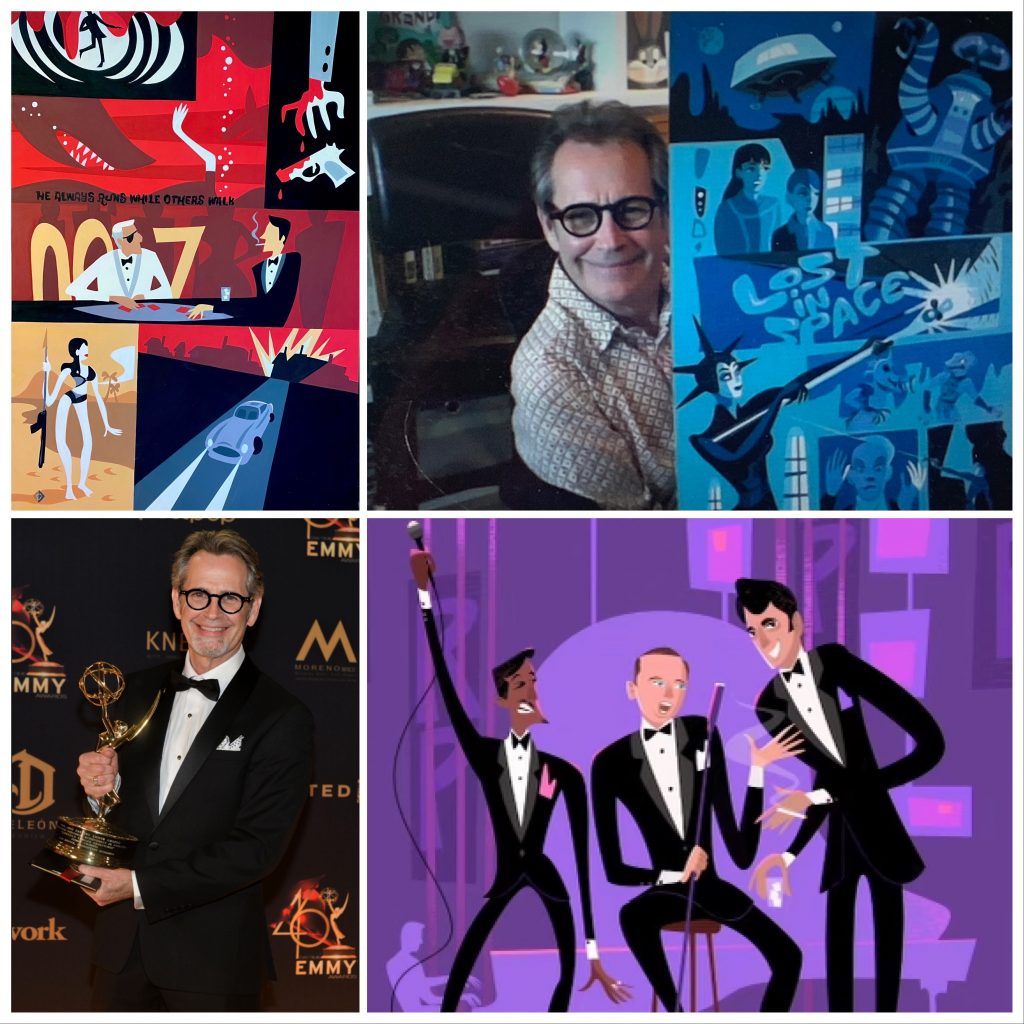So far Alan Bodner has had a career that inspire aspiring artists, and should capture the imagination of animation and film fan, and it looks like he’s just getting started. The Emmy and Annie-award winning art director, illustrator, and fine artist has worked on many favorites from the recent past, and was even the art director of the beloved cult classic animated feature The Iron Giant.
Bodner grew up in the Pacific Northwest, in Portland, to a family that was forever inspiring to him. His aunt was a dancer who had worked in Martha Graham, and his dad had a toy business. His childhood was full of toys, and games, dance and music, and it stuck with him. Though he planned on studying to be a dentist, fate and his own talent had other plans. He wound up studying, instead, at the Art Center in Pasadena, then almost immediately got a job in the animation industry.
He began his career by working at Filmation Studios in the late 70s, surrounded by some of the best artists in the business, and was eager learn from them. He was also an immense talent, and started being recognized as such. One of those taking notice was Brad Bird, who was looking for an art director for his 1999 project The Iron Giant.
He has since worked at nearly every studio, as a background artist, in visual development, and as an art director. He was at Filmation in the early 80s, where he created backgrounds for She Ra, Flash Gordon and Blackstar, to name just a few. He was spent part of his career at Warner Brothers, where he worked with some of the greatest artists in animation history, and was a background artist on shorts like Daffy Duck’s Quackbusters, Invasion of the Bunny Snatchers, and Box Office Bunny. At Disney, he art directed for beloved fan favorites like Kim Possible and Phineas and Ferb, and won a Daytime Emmy for Tangled: The Series. He is currently art directing on Mickey Mouse Funhouse.
All through his career, he has set aside time to work on his personal art, which is inspired by his childhood, the nostalgia of bygone days, and the mid-century modern style of the 50s and 60s. We are thrilled to add original art to the limited editions recently announced and highlighted at the gallery.
We spoke to Alan about his life, career, and art. What were his inspirations? Who helped and inspired him along the way? What excites him as an artist? Learn all this and so much more in this exclusive interview!
ArtInsights: Tell us about your childhood and how it informed your work and aesthetic as an artist.
AB: I have to admit my childhood was extraordinary on so many levels. Number one, my father was a very creative person, and he was in the toy business with his brother, and they had a couple other partners, they had a toy distribution business up in the Northwest. They were distributors who serviced several states. There was this huge toy showroom, that was really the backdrop of my childhood. I would see all the new toys that came out, and I would get to see showcases for the different people who come in from different stores look at these things. There’d be demonstrations of the toys.
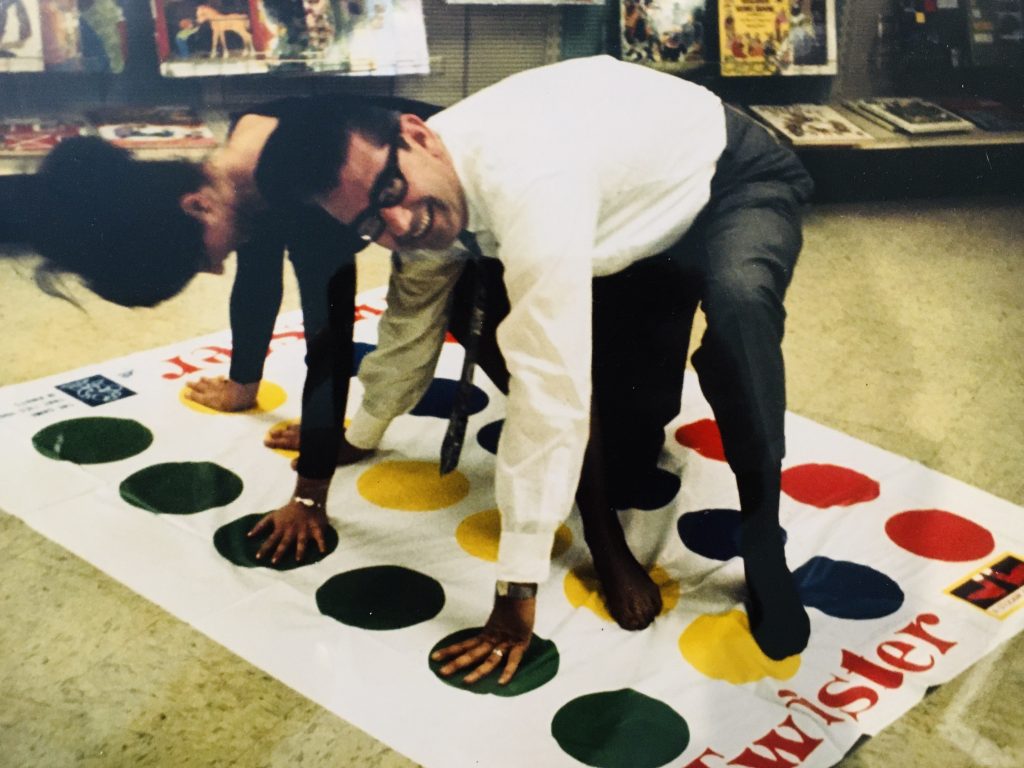
It was so overblown with color and design, but I feel like that just hit a chord with me from the beginning.
I just loved all that fantasy. Plus my dad also had a little connection to the celebrities of the local television station in Portland. Some of these guys had their own kids shows but we knew them because they were bringing commercials from the toy company to the television station. Of course, I didn’t really know a lot that was going on, but I had some pretty great moments. I had a birthday party as a little kid where I came through my kitchen and there was this guy by the name of Dr. Zoom, who had his own TV show. He was sitting there having breakfast with my dad and mom. Fantasy was brought into my life at a very early stage.
On the other side of my family, my grandfather was a women’s coat and suit manufacturer. There were tailors in my family from past generations and I just think that the artistry, from clothing to physical art, it seemed like it was a natural progression for me. I remember as a little boy going to my grandfather’s manufacturing company. He was at the tail end of that business, where a lot of it was like ghosts of the past. There was all these tables and sewing machines but there was nobody using them. It was really like I built in my active imagination all this stuff happening. So for me, I imagined in this showroom all these fashion shows with the coats and suits. My brother and I would pretending we were having fashion shows on full stage.
Did you actually see any fashion shows there?
Unfortunately, I never got to see those, but I saw them via my mother, because she was very fashionable, and there was, continuously, around fashion from the get-go. It didn’t affect my cousins or my brother, but for some reason it hit me and I just loved that stuff from the very onset, so I’m really thankful that happened.
What other influences did you have as a child?
As a kid I took dance lessons and singing lessons. I love my great aunt, which was my grandfather’s sister, in her early days, was a dancer with Martha Graham. She was one of her first students, and they had a lifelong friendship. I saw beautiful photographs of Martha Graham, and my aunt was like my Auntie Mame. She would take me to plays, and had us playing instruments in the house, and we’d be marching around, I mean, she was really great. I’m thankful that I had people like that, who also inspired me to be creative. I had another aunt who sang. My father, at one point, was the president of the Portland Opera Association, and for that year, and I was really a little boy when this was taking place, I remember being taken to the Portland Opera, and seeing that stuff on stage. It was just so incredible to me all that color and design in the costumes and sets. I think in the back in my mind I was just destined to do something with that stuff.
So you went into the arts immediately?
The funny part about my story is that I didn’t think I was going to be going into the arts. I really thought I was heading toward being a dentist, which is what I was studying all the way up to my first year of college. I wanted to be a dentist, because my uncle was a dentist and he was a fabulous person. I thought this until one day I was taking this class at University of Oregon. It was really an art class for my own enjoyment, and the instructor came over to me one day, he says, “What is your plan with your art?” And I’m like, “Nothing. It’s just fun.” He just said, “No. You need to be in a professional arts school. You’ve got to do something with it.” It was just like a lightbulb went on. I had been doing art all along, not really thinking seriously, “this is my path.” My passion took hold, and that fire just lit, and from that point out, I knew I had to find a way to do it.
Your personal work lands right at the intersections of nostalgia and art. The beauty of production and illustration art and the artists who create it, I think, is that with illustration, graphic, and so-called “commercial art”, the artist has to stick to strict guidelines and still create something with their own aesthetic and style, which is much harder than just being inspired and drawing whatever you like. I think that’s just so cool and very undervalued, although it’s changing.
You put it into really good words. That really resonates with me because I’ve had this conversation with other artists that I know who are fine artists and there was always this layer from their side of like “well, you’re doing commercial art. My work is fine art. But I still feel like my stuff is in the realm of real art. I mean, I like the fact that it’s commercial art. I love working at art from that perspective. But at the same time, I feel it’s just as just as good or just as valuable. I’m interested in making something ecstatically pleasing and beautiful at same time as it performs its function, whatever that is.
When an artist is creating something in which they have a brief to follow while at the same time making it aesthetically pleasing and recognizable as their work, I think that’s challenging. So I find that so impressive and exciting.
I love the collaboration that takes place with other artists, especially in animation. I really appreciate what other people do and what they bring to it, and finding my place in there is really wonderful. I learned so much about design and color from animation. There are so many great artists in the history of animation and to bring me into that industry as an apprentice and learn from some of the greats. It has had such an impact on me.
Talk about that! Where did you apprentice?
Well, my first job in animation was that Filmation Studio. It was a really great time because it was the late 1970s, and a lot of older animators and artists in the animation field were retiring and all of a sudden, they started to realize “We don’t really have a young core here, and we’re haven’t really been pushing this.” They really knew that they had to make a choice, and they started to have these apprentices. I started to call around to the animation studios, because I loved animation. I was so influenced by the commercials when I’d sit there watching these cartoons every Saturday. I thought, “Where’s that?” Because in art school, they never pushed animation. Their noses were very much up in the air about animation and never I brought it up in school because, like, “that stuff is not art”. And I was like, “Well, yeah, it is. It’s really beautiful stuff.” So I went into Filmation and showed my portfolio and the man who saw me was in their layout and character design. He looked at my stuff and he said, “You probably could do drawing here, but you have a color sense that’s nice. I’m going to take you down to the background department.” I had no idea with that, but I walked into the background department and was introduced to Erv Kaplan and on his wall were just these unbelievably beautiful paintings, these little tiny, beautiful paintings and scenes from all these shows that I had loved as a kid. too. And he says, “I like your work.” About a week later he hired me. I’m grateful to this day that he did that, because I learned so much. So so much more than art school, I went to a really good school, there’s no question about it. I was finally able to understand what it was that I was supposed to be doing. When I got this job, the artists in the department would really become mentors to me. There were so many amazing talents. These people were Disney artists, Hanna Barbera artists, and they were all in this room. Everybody had been in major studios, and to have these people literally take the tools out of my hand and say, “You need to do this when you’re painting.” There were so many things they helped me understand, and I was working hard but it was so much fun.
What were some of the projects that were really fun at Filmation?
On the Fat Albert series, there was this little section in there called the Brown Hornets, which had a design-y style that the kids in the show would watch on television, I remember. I loved that stuff, and I really started to gravitate toward the more stylized looking cartoons.I really got some amazing education there.
What were the steps that got you from Filmation to becoming the art director of The Iron Giant?
I was at Filmation, they went through a big strike about four years into my working there, and at that point it didn’t look like animation was doing all that well, so I went to New York and was working at ABC news there as a news graphic artist for four years. I made a connection before I left to go to New York with Dick Thomas, who was doing some art for a toy company, and I got to do some art for him. It turned out that Dick Thomas was this great background artist, and he was also working at Warner Brothers. And, and he had been with Warner Brothers, Disney and Hanna Barbera. He was really a seasoned talent, and we had a nice rapport. While I was in New York, I would periodically keep in touch with him just see how he was doing, as he was getting older. About four years down the line, I decided to come back to Los Angeles, and I connected with him and he said he wanted to hire me. That was the beginning of my 15 years stint at Warner Brothers, which absolutely is one of the highlights in my career, with some of the most incredible artists, who at that time were still alive.
At that point, yeah! Unbelievable. Geniuses, really.
That was a tremendous learning experience. It’s like I went from first grade through high school at Warner’s. It was absolutely wonderful. I learned so much about designing color, I got such a gift on that one. I was in Warner Classics, which was a very small boutique department. There were really only 30 or 40 of us at the most. We were doing shorts, art for the stores, and we did commercials, and it was a beautiful time period. I worked with so many great talents and was so honored to be part of that. Mel Blanc, Friz Freleng, and Chuck Jones were all working there then. These guys were really part of that those crews that did the most classic cartoons for Warner Brothers. I was so touched that Mel Blanc gave me a credit in his autobiography, he actually talked about me as one of “the new kids”. I went to Mel Blanc’s birthday party on the lot. I just thought, “Man, I really don’t know how it gets any better than this.” To be in the room with people like Kirk Douglas, who were his buddies, it was crazy.
That’s so funny, because I started selling animation in 1988 and just got to meet and get to know so many great artists before they passed. We were both so lucky, and I think we knew it even then.
I could not agree more. Just to be around Maurice Noble, I would show him my stuff. I was such a huge fan, and to have him there, when I was trying to sort of maintain the feeling of what he had been doing in the 50s and in his work on those cartoons. I’m very influenced by it, and I don’t have any problems saying that.
I see in your work influence from Maurice Noble, and that spectacular intersection of shape, form, and color. He was just in a class all by himself. When you see your work now, where do you see Maurice Nobl
In my shape language. I can really get things very abstract. I love working abstract, just to loosen me up. And I have lots abstract pieces that I just are all about interesting shapes against each other in different color combinations.
(see below for original 3D art by Alan Bodner, inspired by his love of abstract shapes and color designs)
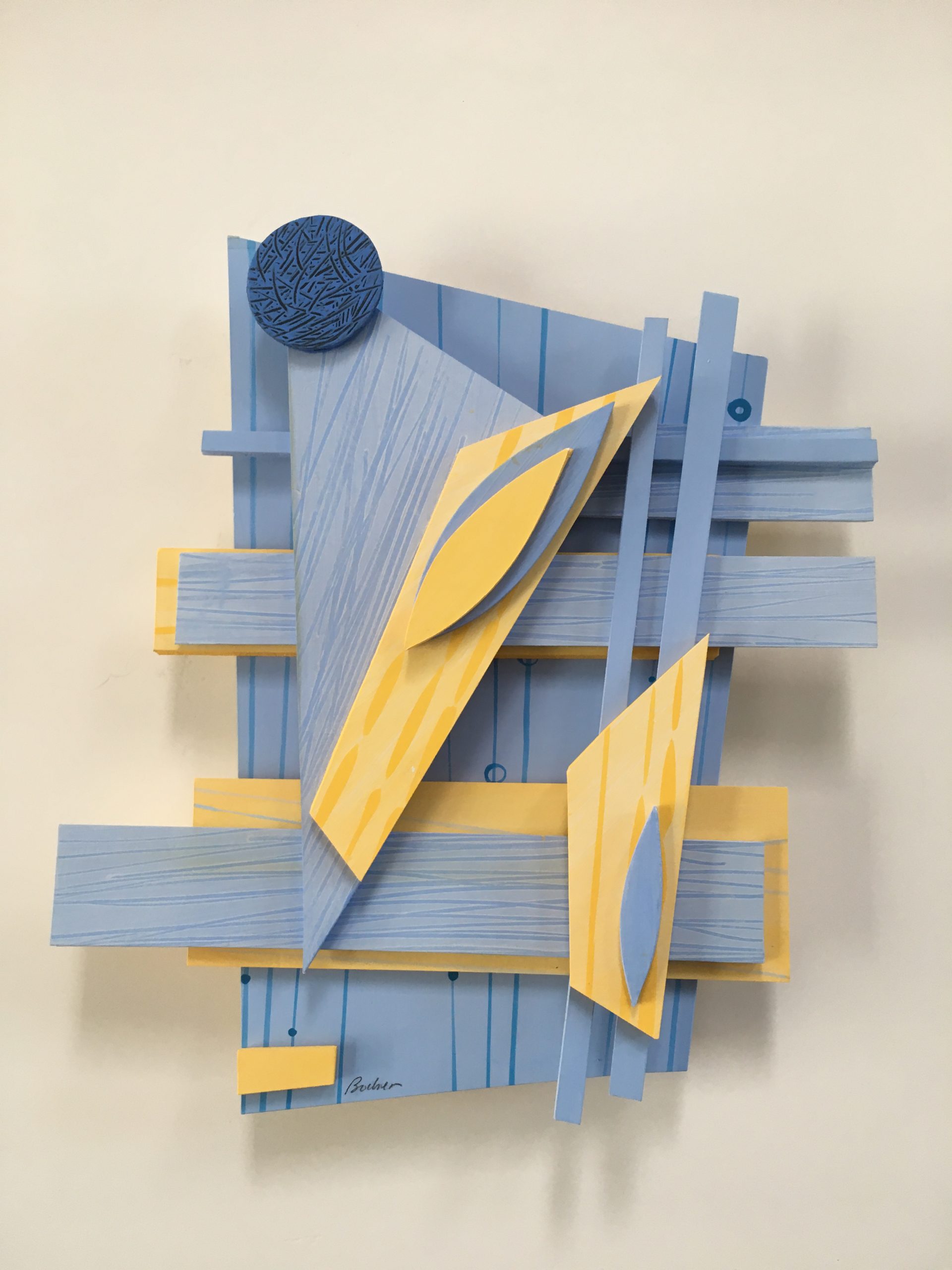
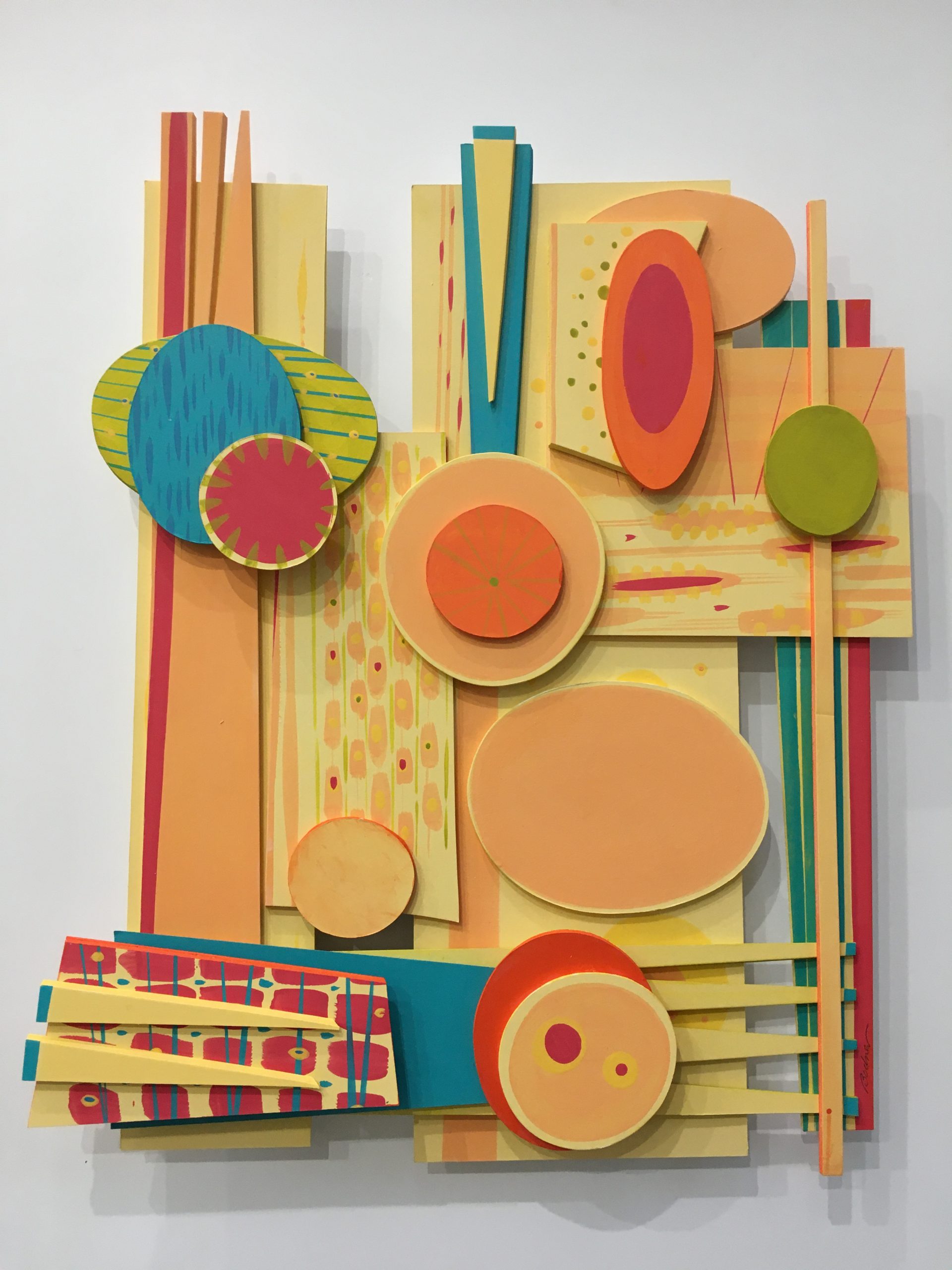
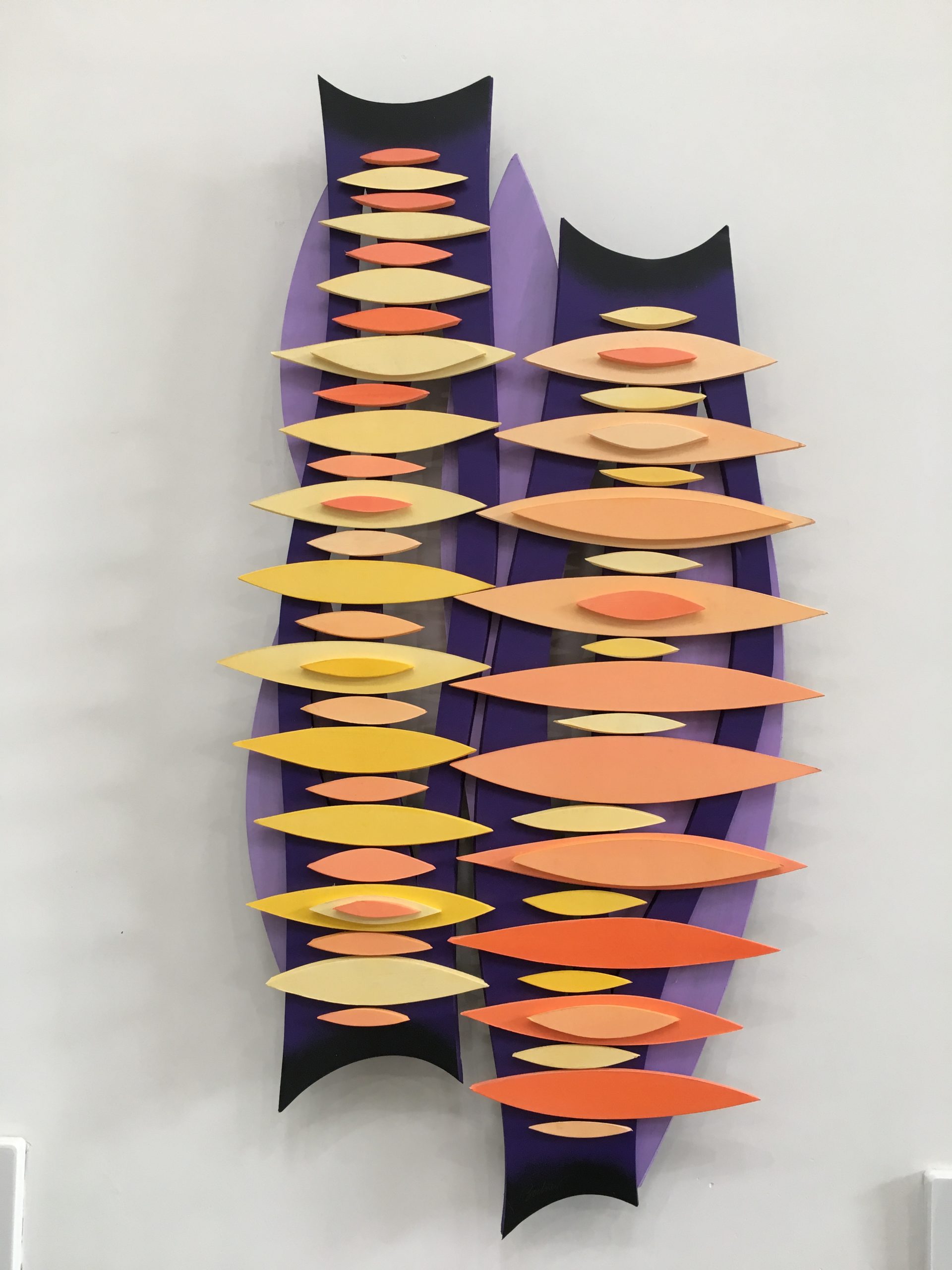
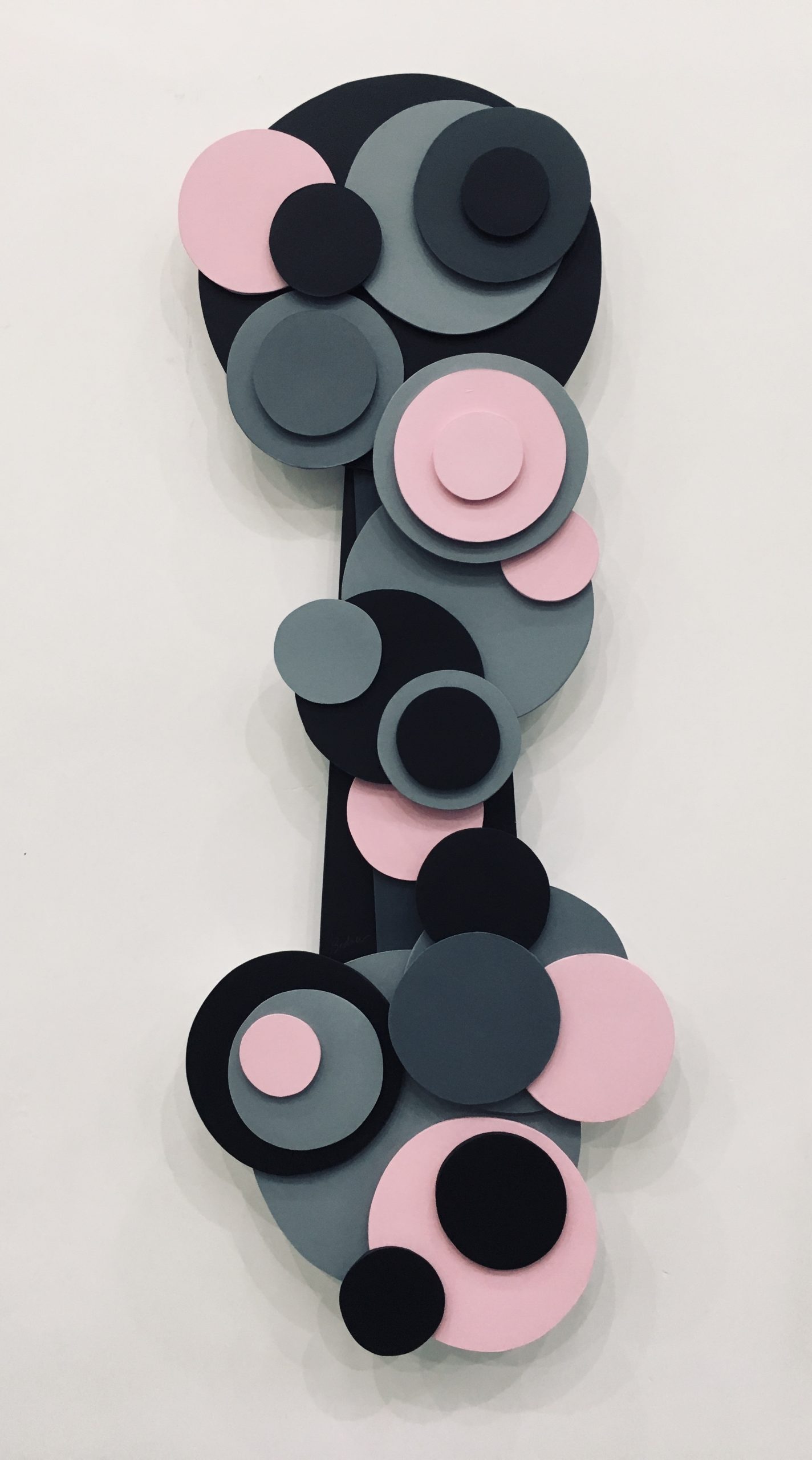
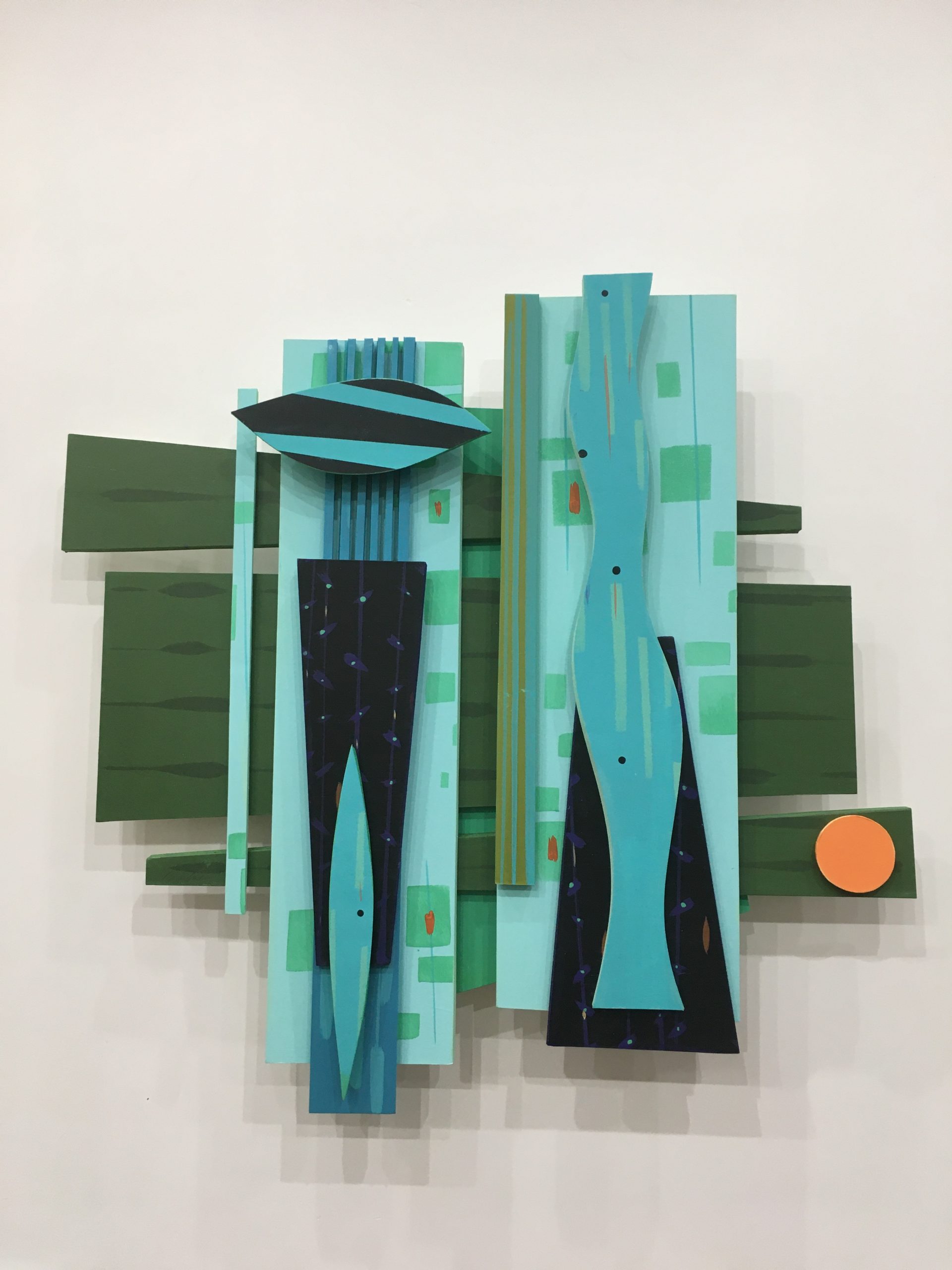
And I think that’s something that Maurice nobles was a master of. It wasn’t so much that the perspective was right. I don’t really care about the perspective being right. It’s more about what shapes look good against each another? It’s a balance of shapes. I try to create art with shapes that flow into each other and show movement. I think that was a very big thing, even in What’s Opera Doc, the backgrounds and the shapes of those columns. The last thing he was thinking about was making sure that the perspective was correct. He was just trying to make sure everything was kind of weighted properly and it’s believable perspective, but it doesn’t have to be accurate. I love that because it’s so freeing. .I can just say, “This is what it is”, and the viewer believes it.
After saying that, I can your influence and your inspiration from Noble in your art direction for so many shows!
With so many creators you couldn’t get away with anything like that, because they were so interested in proper perspective. But who cares about that?
It’s a cartoon!
Exactly! That’s why I like stylized cartoons! Because it’s fantasy. That was not quite the case in Iron Giant. I had been doing all this Warner Brothers stuff, and going home and working on my own art, which I started to do about that time, and I was starting to do abstracts, I went in to talk to Brad Bird, and it was a friend of mine, Harry Saben, who recommended me. We had done all this stuff together at Warner’s. He went to art school with Brad, and Brad saw him told him he was looking for an art director and asked for recommendations. Harry was gracious enough to bring up my name.
(Below are some wonderful images created by Harry Saben and Alan Bodner together for the WB stores)
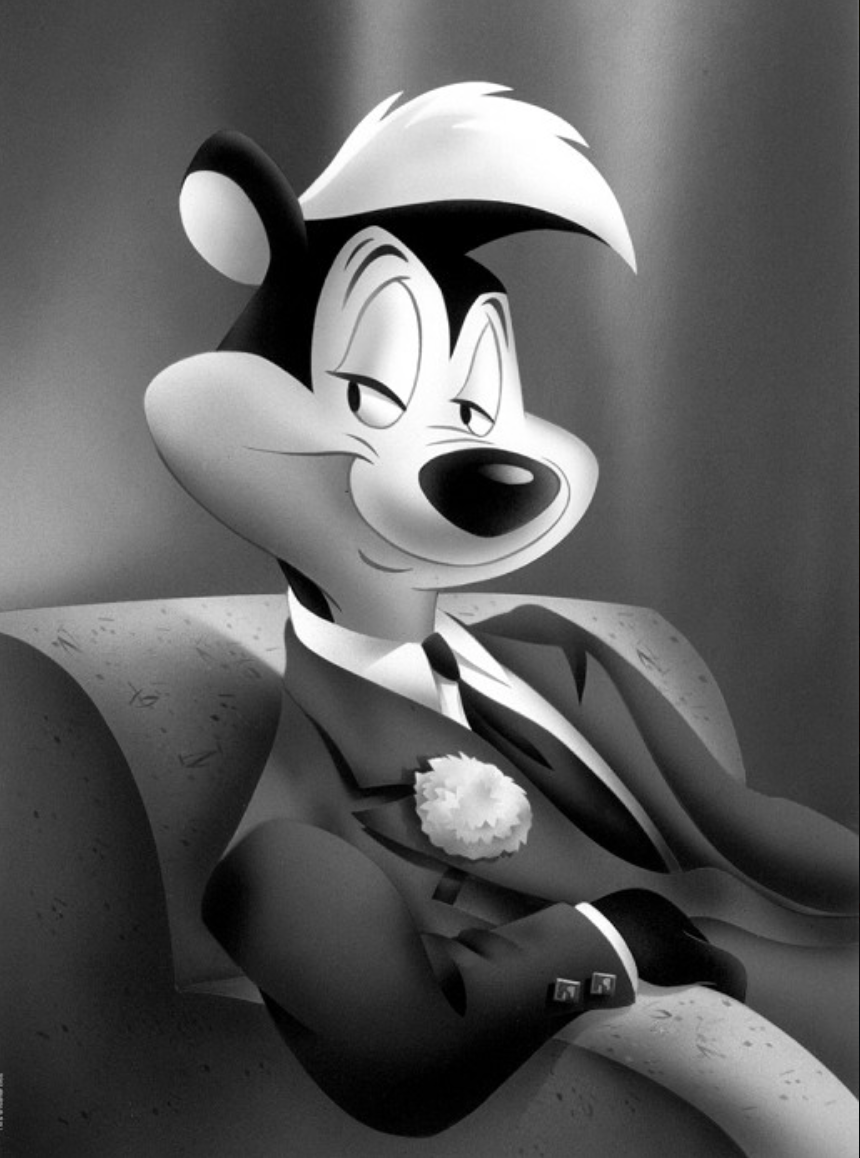

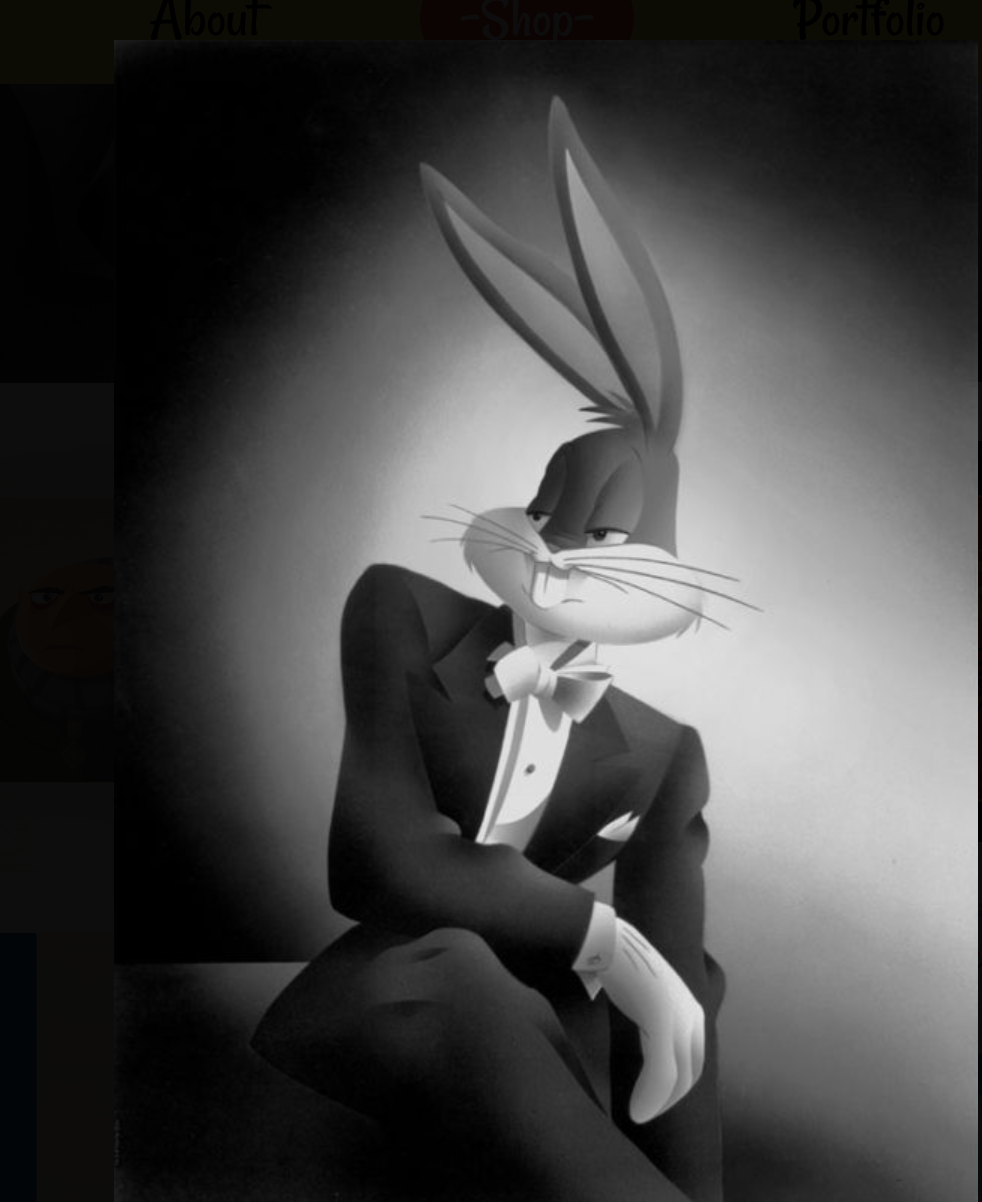
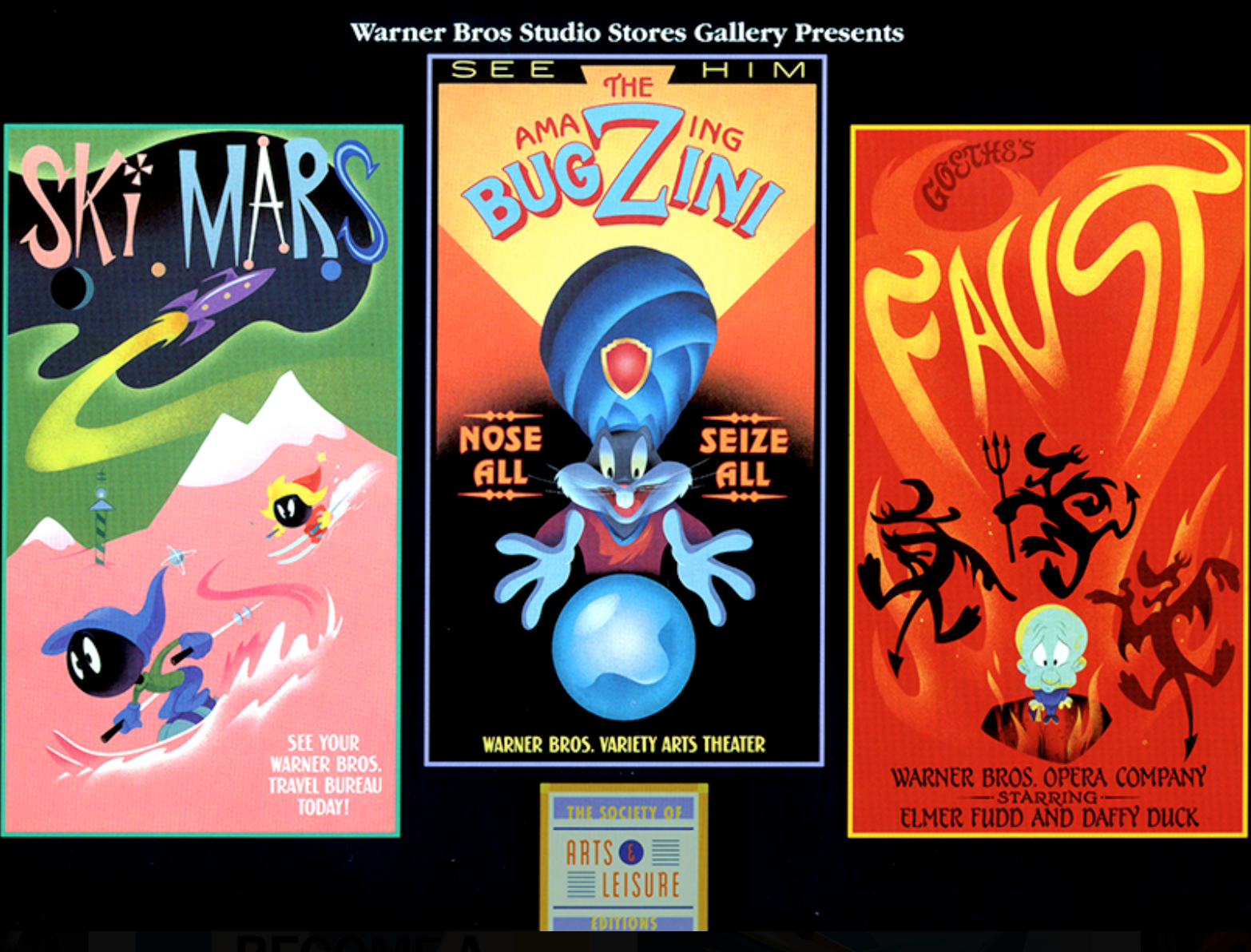
I really did not want to leave Warner Classics. I was enjoying myself. I really didn’t have any desire to go, because I was enjoying it so much. But I went and I saw Brad, and I saw the stuff on the walls, the development was so cool, the whole idea of a giant robot, and it was a feature. I’d never worked on a feature, and quite honestly, I was just beginning to be an art director. I had only done like a couple of things where I was being given the title of art director. I was really a background artist, and I loved being a background artist. When I went and I talked to Brad, he said, “Well, I really do need an art director. I like your work, but what I really like is your color and your abstracts.” I was showing him my own personal work. It wasn’t really my backgrounds from Warner Brothers that interested him, it was my fantasy stuff. Then he called me back and said he wanted to hire me. He wasn’t sure what exact position but he wanted me on the film. I knew that I really didn’t know what an art director fully did. I started to do what I thought were color scripts.
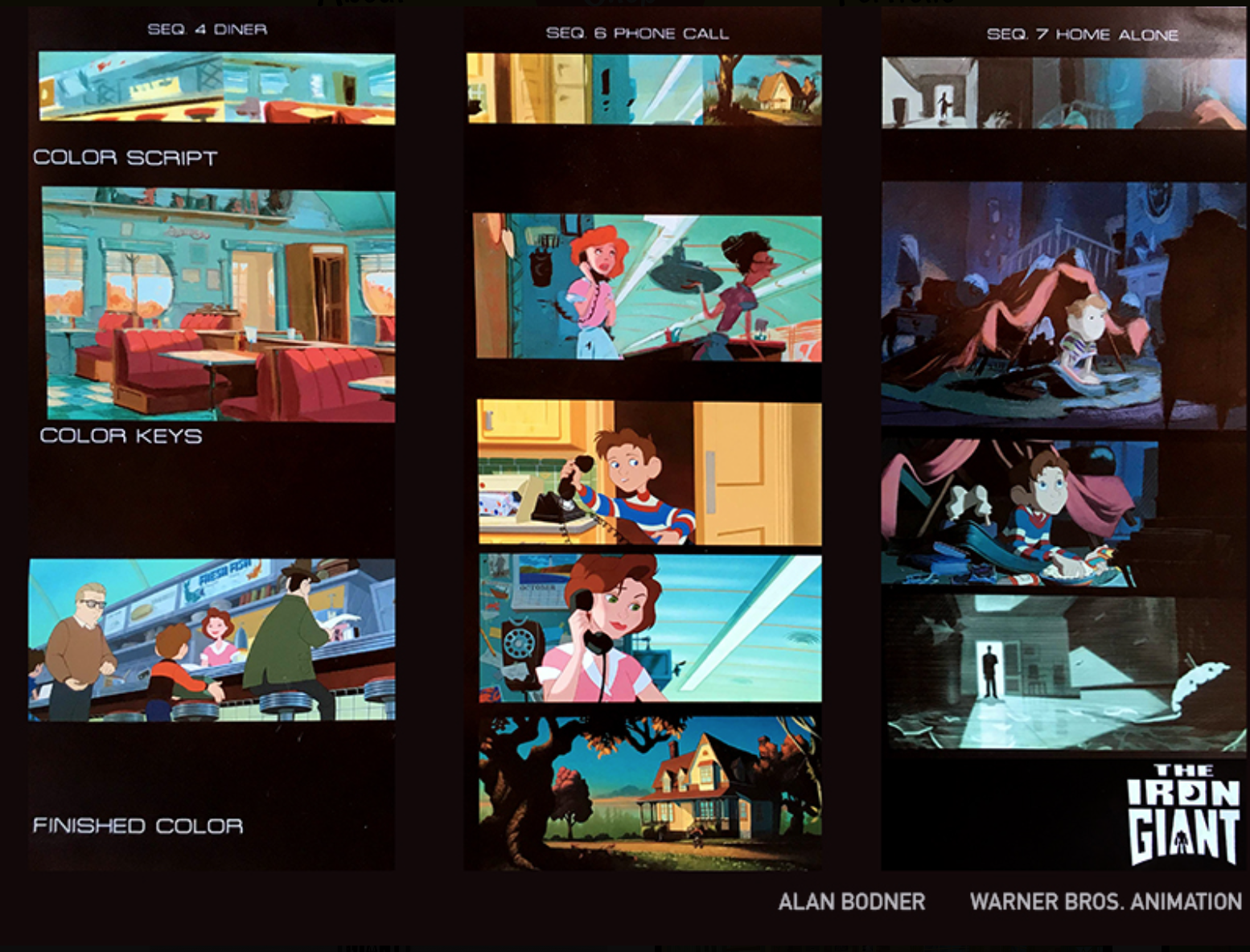
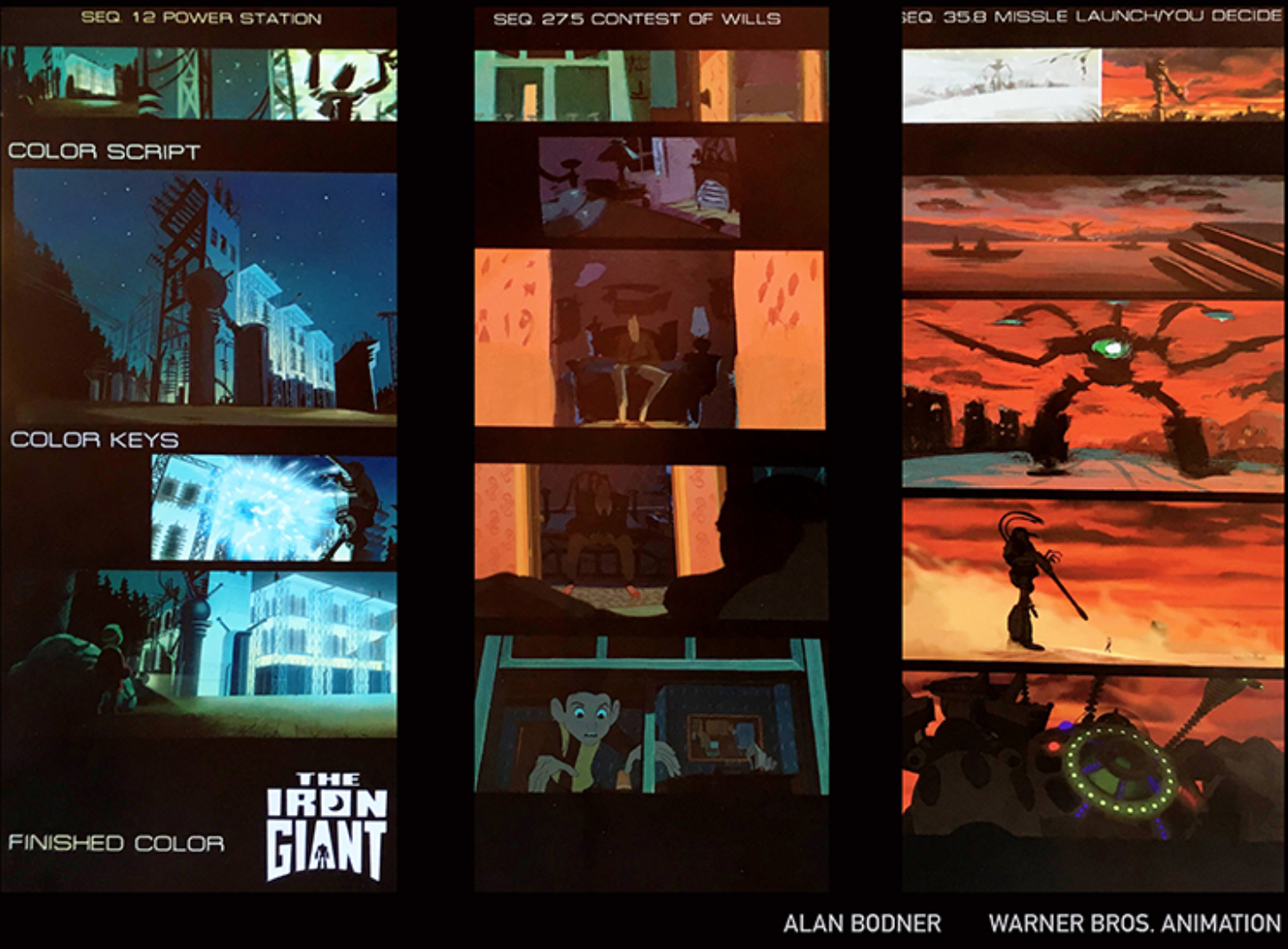
I’d go through the film and take out different moments and put together a little color script of these major moments. I was still painting. The computer was coming in, but it hadn’t hit me yet. I was trying to learn how to use the computer, but I was still painting traditionally, and there wasn’t a lot of time for me to be doing these little colored rendering, because my job included me going around to the background department and layout department, and talking with the heads of those departments, and then meeting with all of these artists, and I had never had to deal with 15 artists in each department.
That must have been a lot!
My day would generally be I would walk around to each department and see what everybody was doing. I would come back, and I would meet again with Brad, and he would look at it, and I would be with him. I really trailed him for a couple of years. It was like college education again. I’m learning from him. I’m hearing everything he’s saying. He’s making references to live action films. Now I’m watching live action films. I’m actually going through live action film, and copying scenes that look very dramatic. He was telling me “Don’t look at animation stuff. Look at live action stuff.” I started to do that, and I found it very fascinating, and I started to really go through it. I would keep on building, go back to my room and build that color script. I really wish that I had more experience on the computer back then. Now, I use computer every day and I love it. I remember at moments, I was excited and thrilled and at the same time scared half to death because I had to deal with all these artists. I’m very diplomatic. I don’t ride people. As a director, I just really want them to do the best they can and take ownership of what they’re doing and at the same time have fun doing it.
How has that changed over the years since now you’ve been an art director for many years.
If I love any aspect of the show I’m working on that I will take a lot of ownership of, it is in color scripts and color comps. I still like doing that, and I feel like, you know, I can keep a consistent and interesting look to the show. I don’t spell those things out to the Nth degree that I’ve painted the whole thing, I just give a very simple color direction. I’ve often felt that the simpler I can make this, the better it’s going to be for them, because then they have a lot they can bring. I don’t stifle creativity. I’m looking at the whole story.
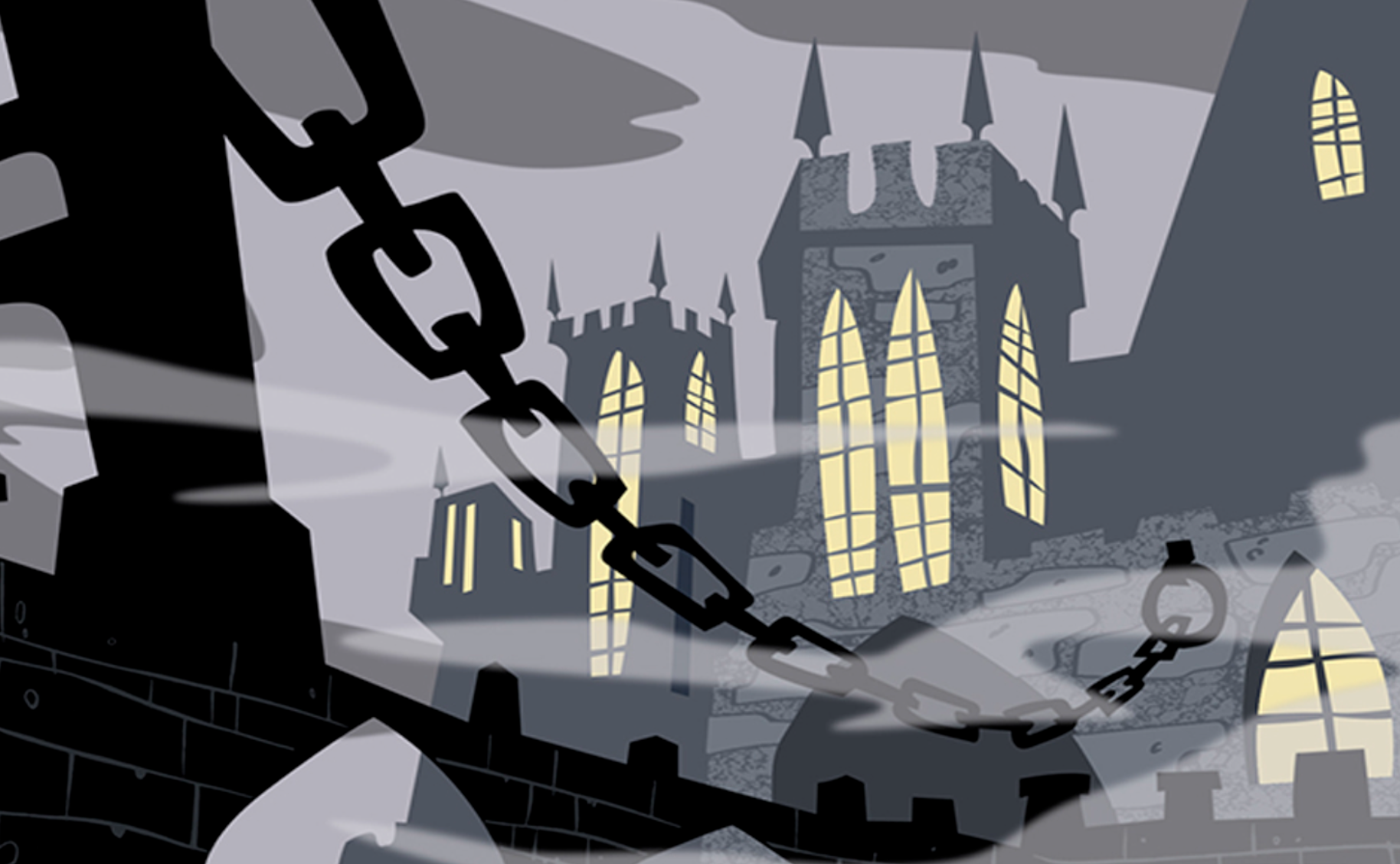
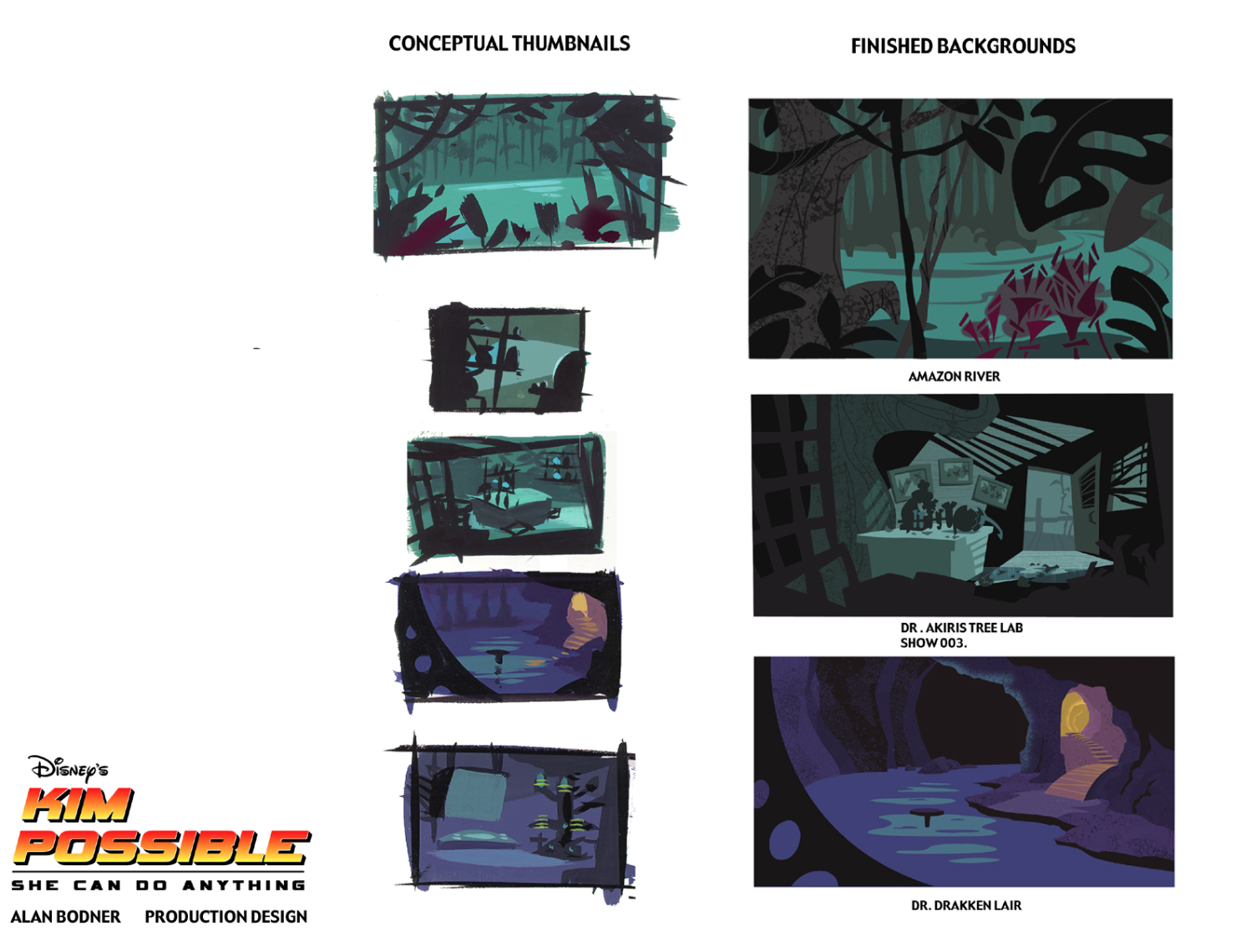
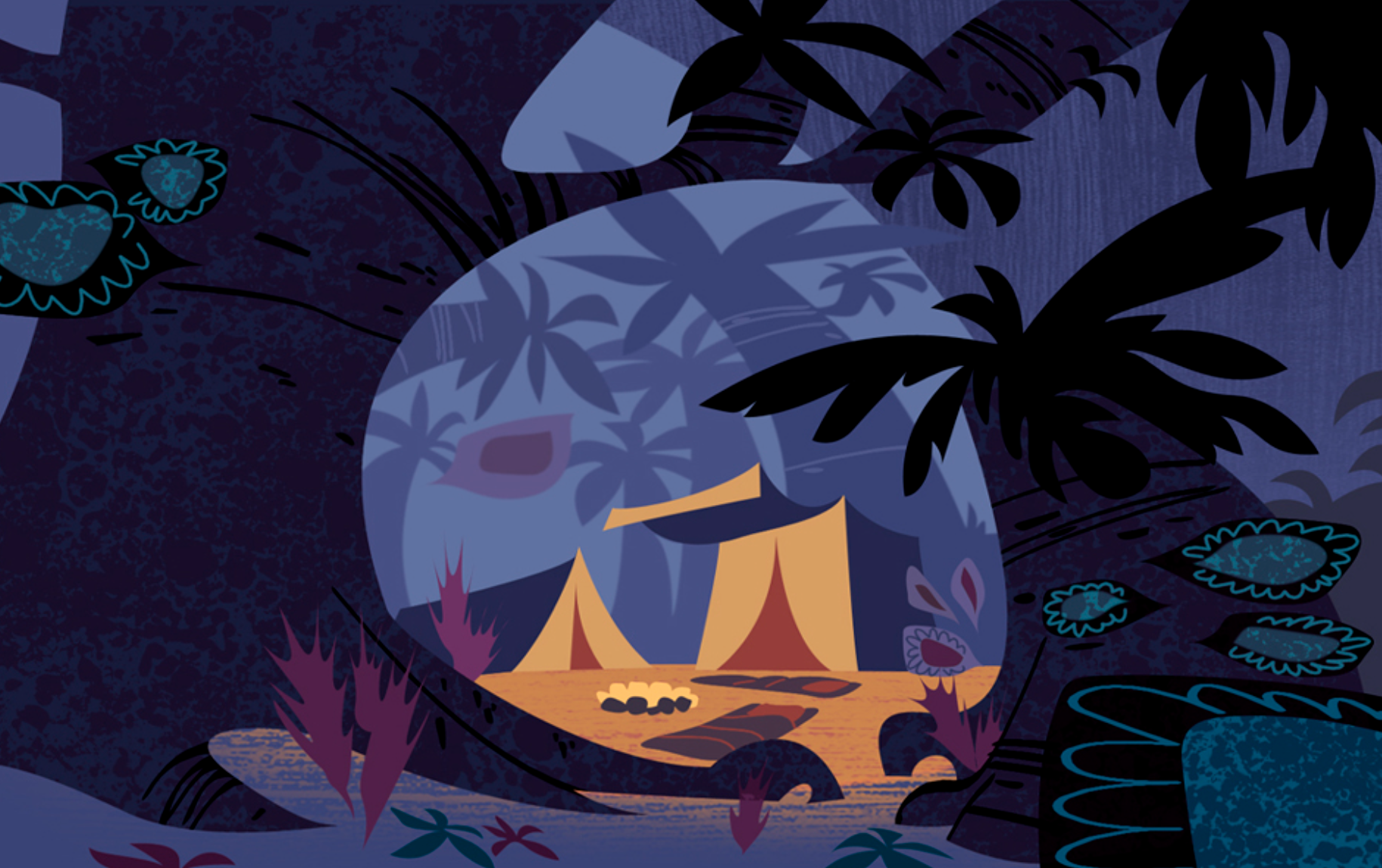
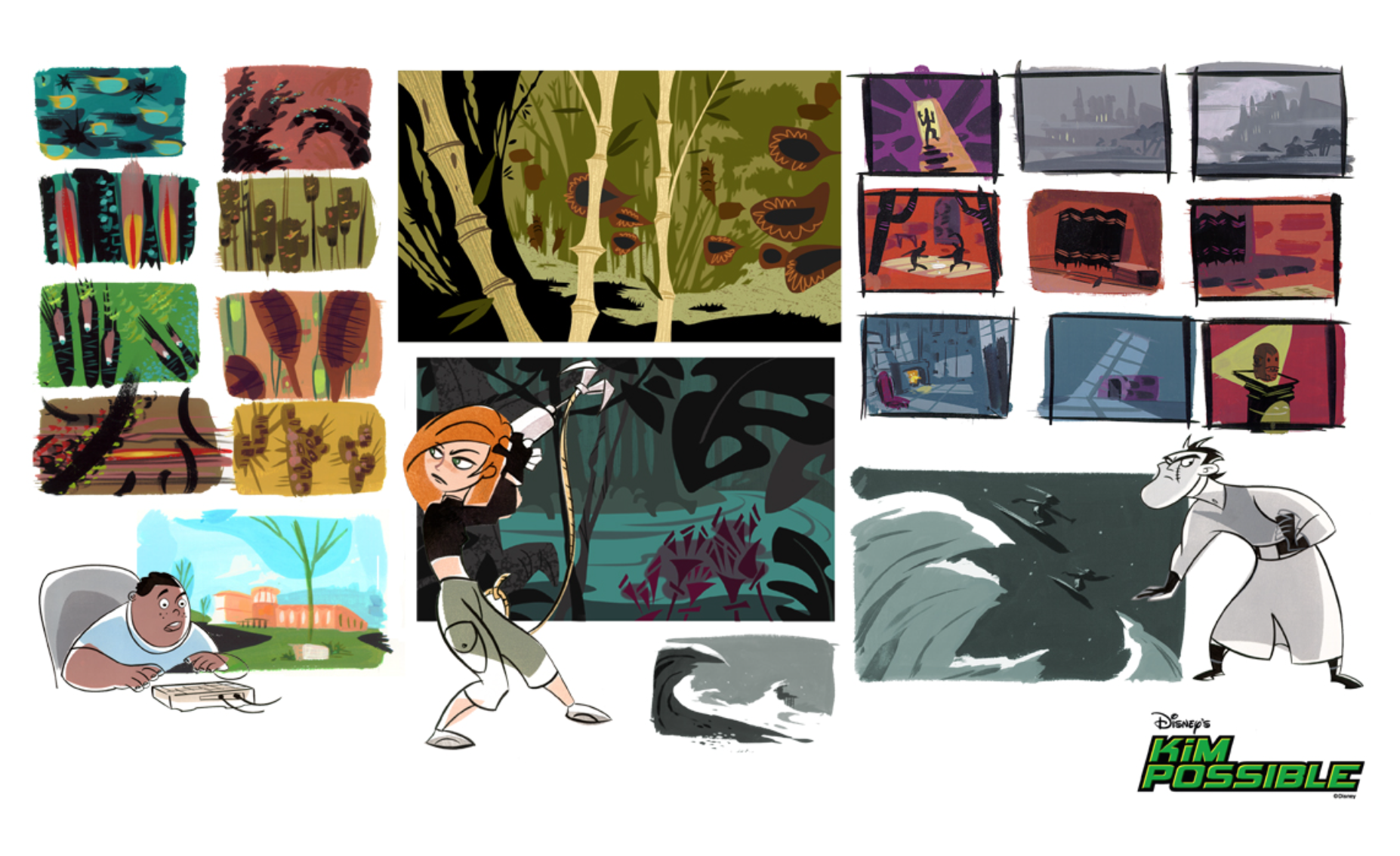
That worked really fabulously on Tangled, because those stories, those are like little features. We were doing a feature for every episode. I could put in the color script in the characters and the backgrounds very simply, and get a whole point across. I’d have the director and the producer in my office every week looking at these color scripts, and we’d go through it, and once that was hammered out, then I’d hand that over to other stylists, and to the background painters. It worked out beautifully. It was consistent.
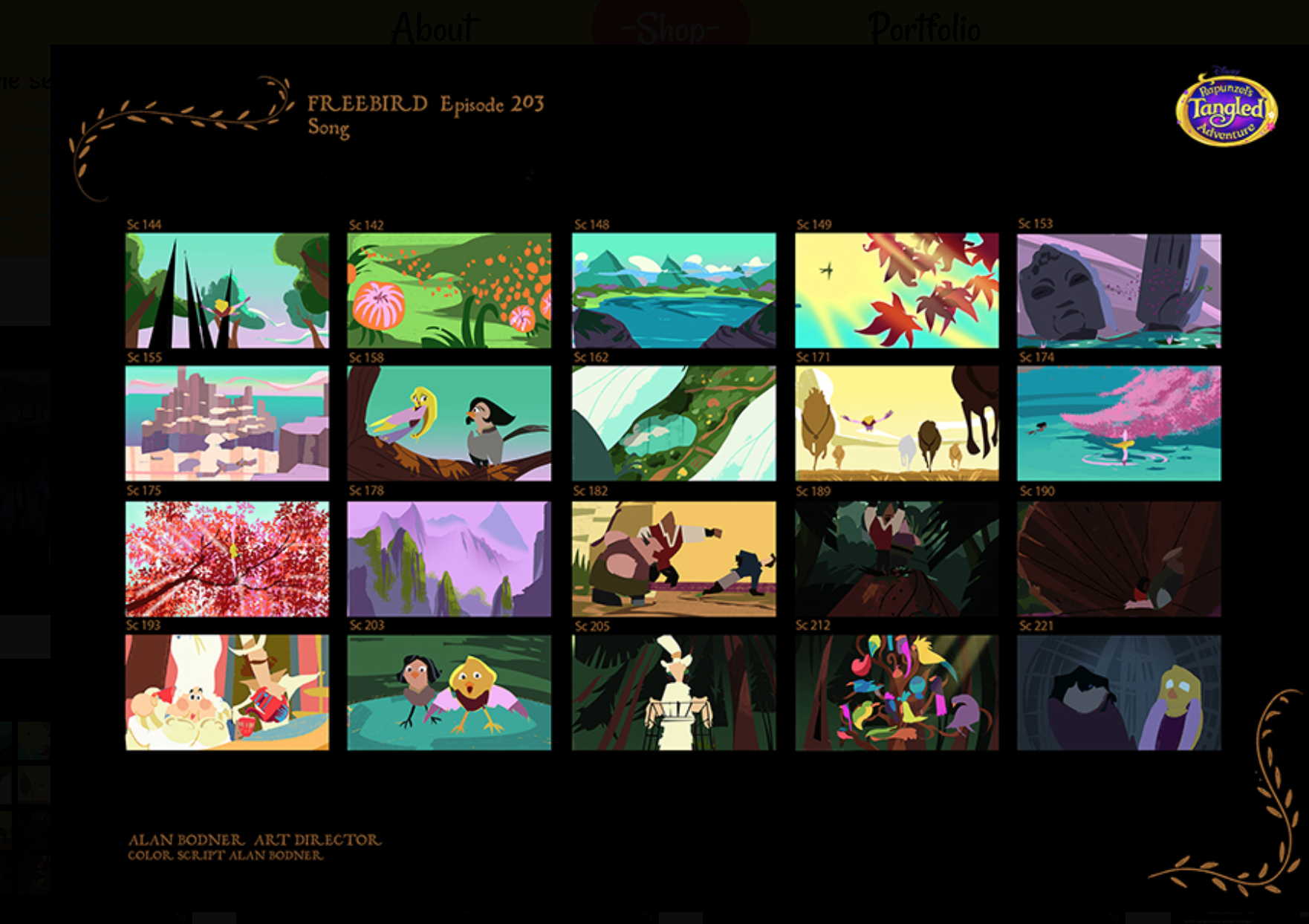
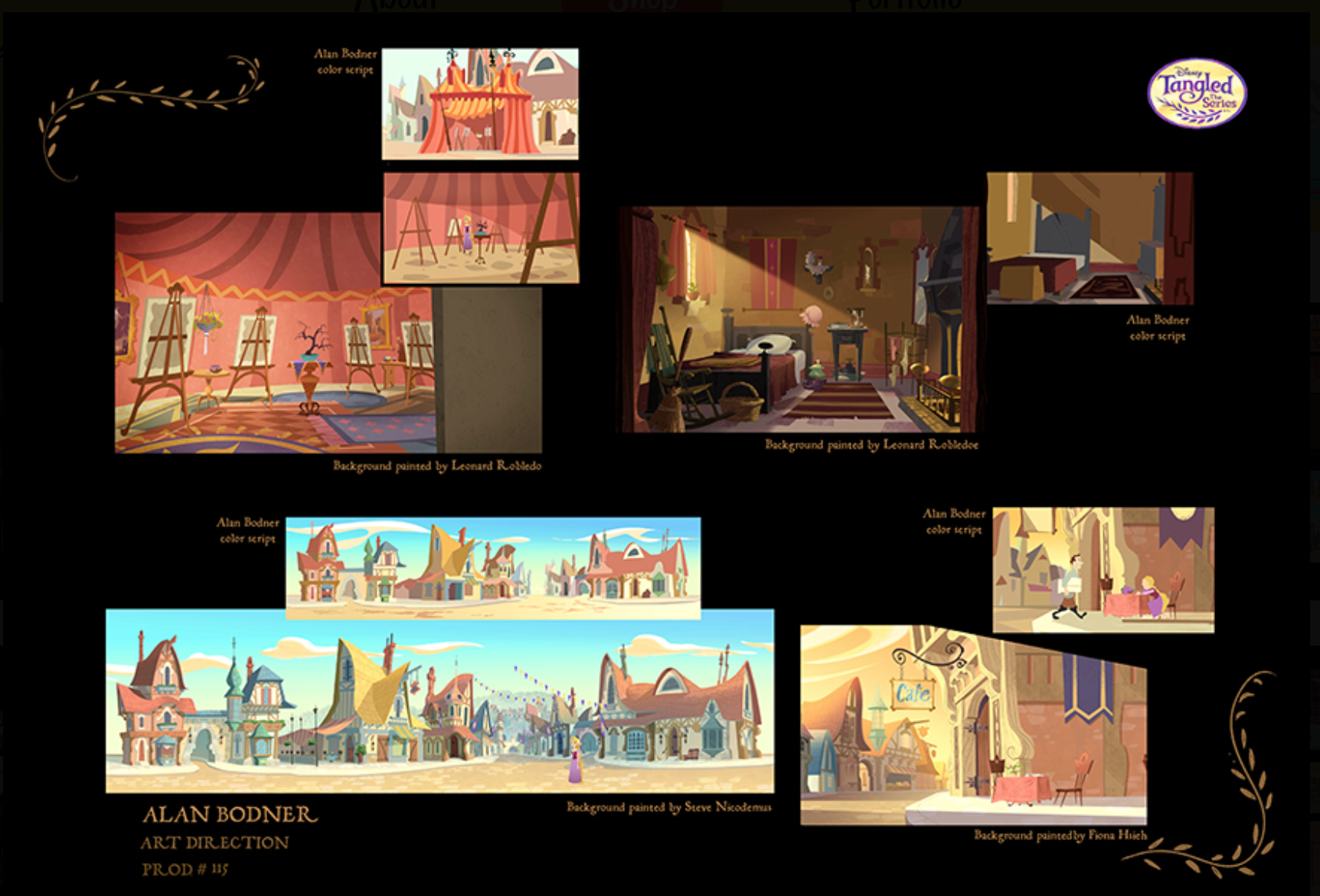
And you’re working on Mickey’s Funhouse now.
On Mickey’s Funhouse. It’s not so much about color scripts, as it is, the environments. I get really involved in, “What’s that environment looking like?” I want to make sure that it looks different from the other one, and I want to try out different colors. I don’t have to make blue skies, I’m not interested in that.
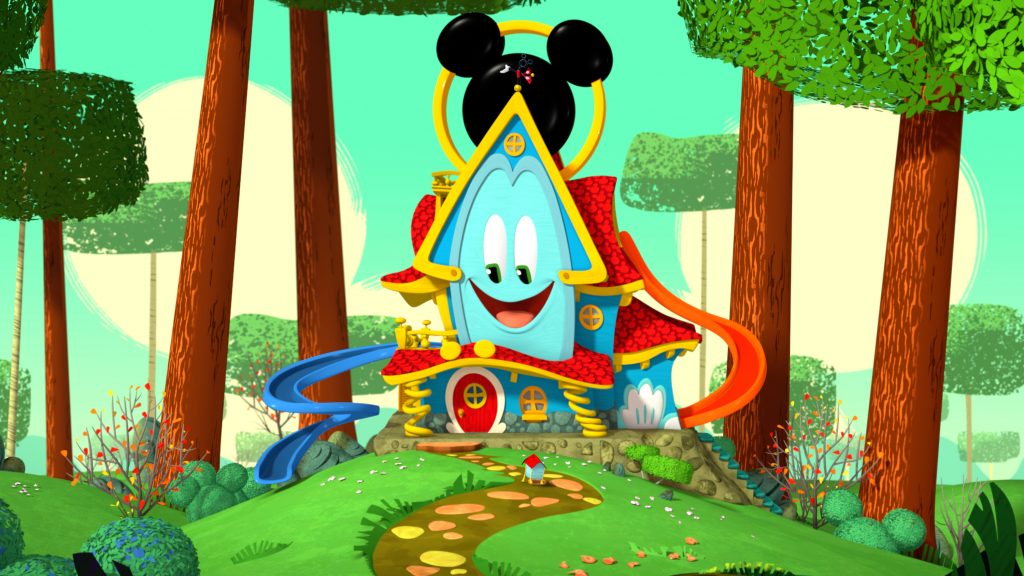
What other colors will make this thing interesting and fun and playful? I’m very involved with that, and I hand that stuff off to the background artists, and the color stylists, and layout department. It’s a joy to play to all the strengths of everyone working on the show.
Looking back on some of the shows and movies you’ve worked on, what is a great example that represents your aesthetic as an artist and something that examples the influence you’ve had?
If I was to think of a show that really resonated with my own styling, it would probably be Kim Possible, because I started just to tell myself how little can I get away with on this background and still feel like there’s lots of dimension to it, and how little I can put into these backgrounds texturally and still feel like it’s full and gutsy. That was really challenging and really fun, because, there’s a lot of depth designed to those things, and I got to work with some amazing talents on that show.
I’m going to shift a little bit to the art that that you’re doing now and have been doing for quite some time, your personal work.
I started doing these musical things, when I was at Filmation. I put them in a box and I let them go. But then as the years went by I started asking a question to a lot of people who were retiring, and getting older. “What are you going to do when you retire? What’s your plan? Are you going to do your own art?” They’d say, “Yeah, I got plans to do my own stuff. I don’t have the time to do it now.” And I watched this unfold. A lot of them didn’t. They’d say they’d be working for 45 years and they didn’t want to do art anymore. And something went off on me again, I just said, “You know what? I am not going to do that. I’m going to start doing my art now, and maybe I’m only working on it a couple of nights a week, but I’m going to do it now.” I started asking myself what I really loved and what I wanted to do for myself. What do I really enjoy?I just decided to take themes that I’ve always loved. I wrote a list. I love dance, music, movies, tv shows, commercials from when I was a kid.
(for his personal work, Bodner started with colorful images of women in music and dance images..)
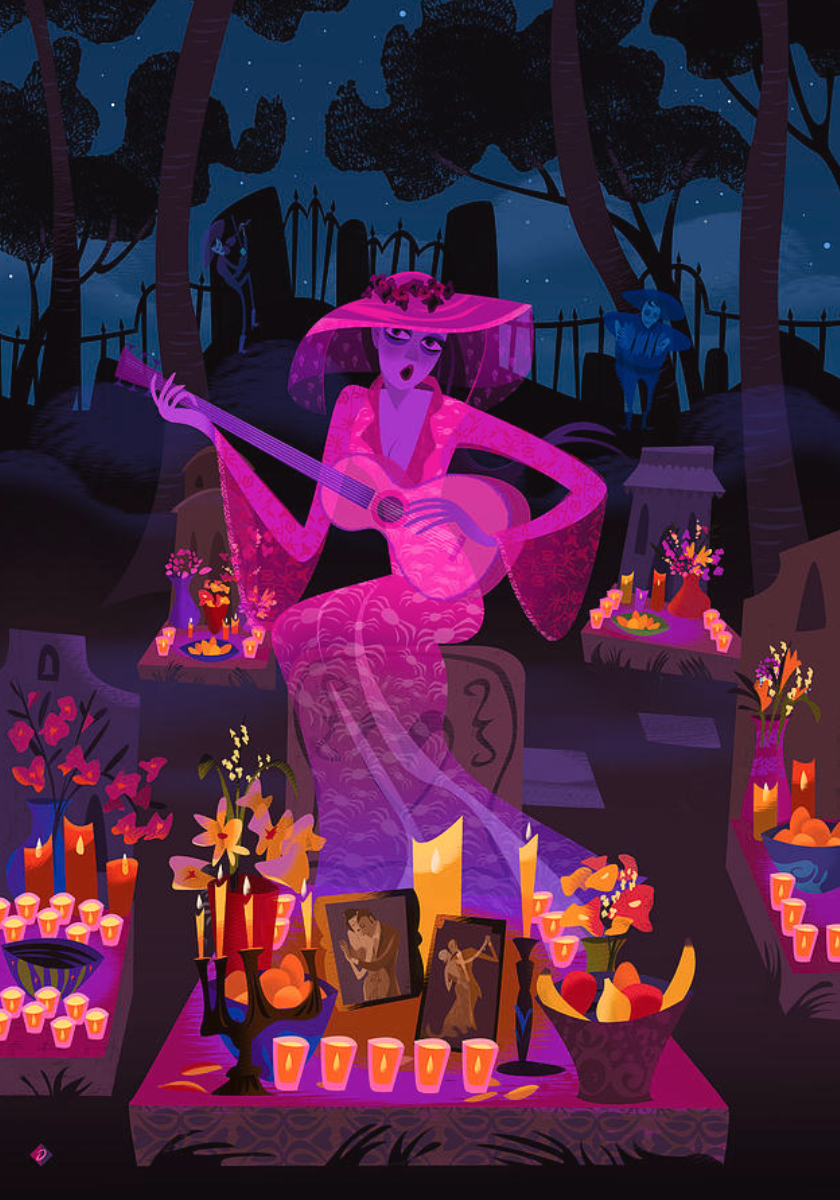
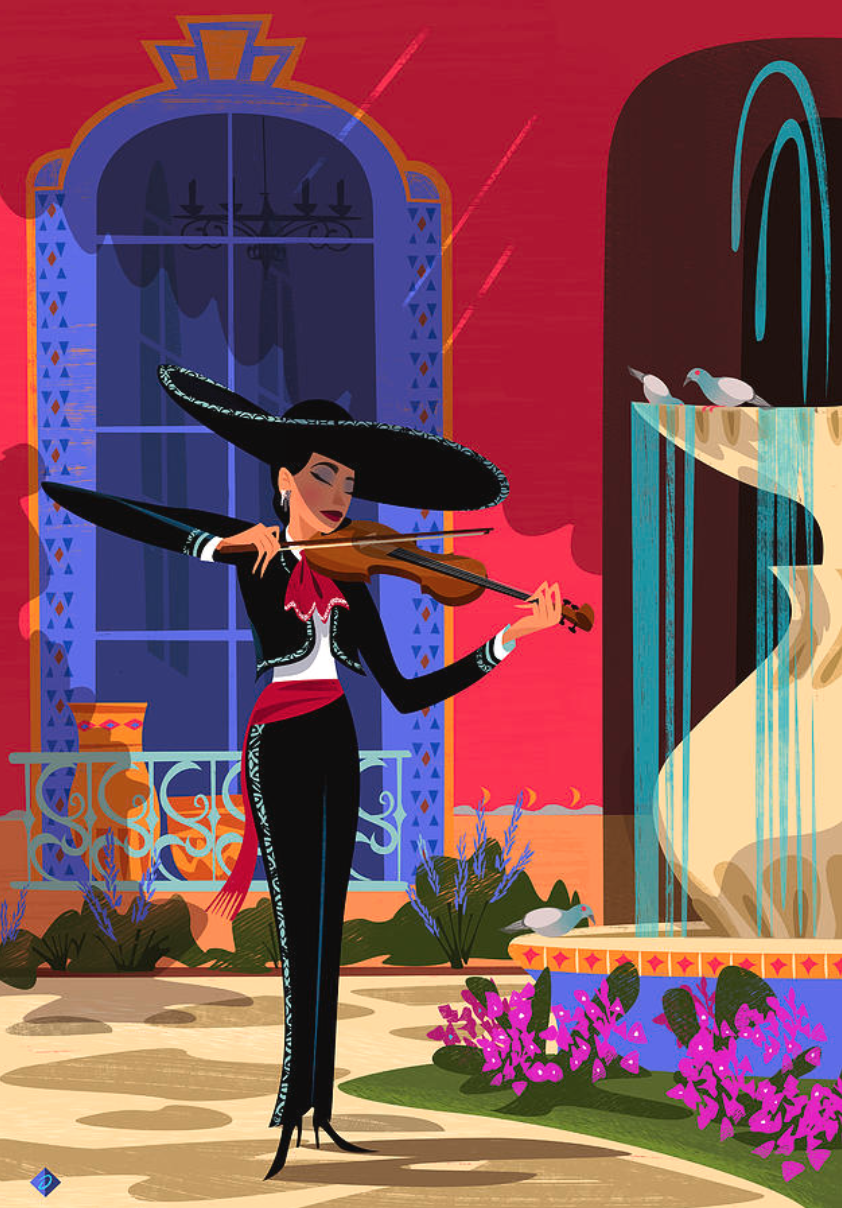
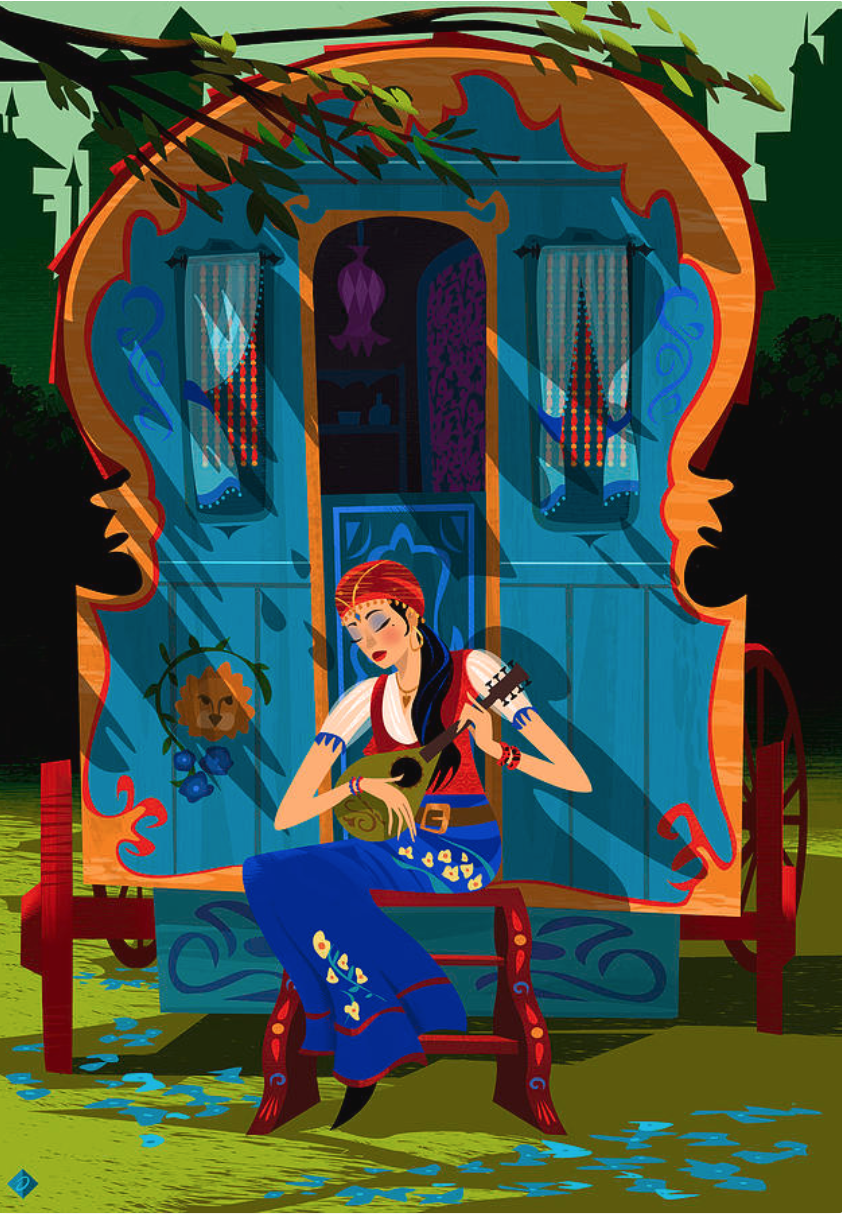
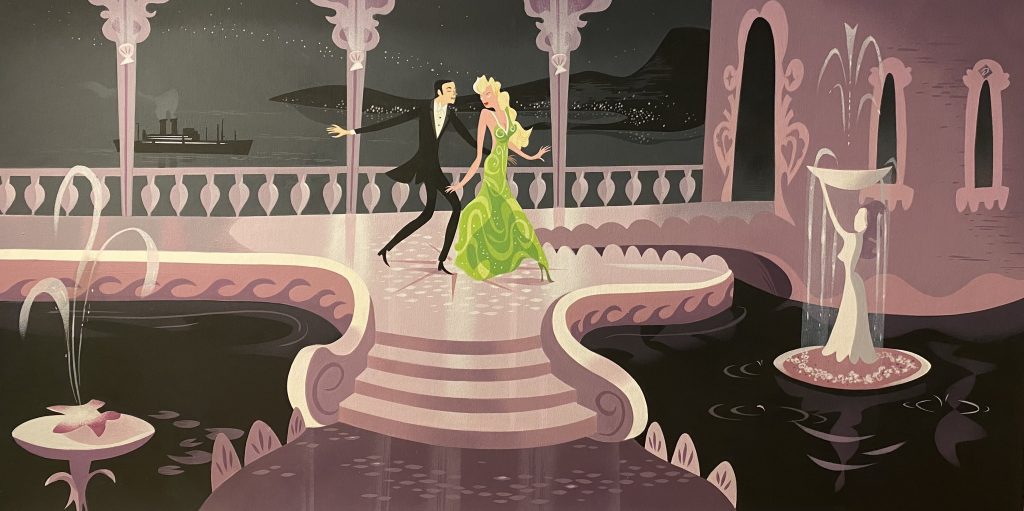
To see all art available by Alan Bodner, go to his ArtInsights artist page HERE.
And I said, “Okay, so now you’re going to do 10 pieces of each one.” At least I set a goal. And I work a lot, but I committed a long time ago to keep at this list of what I’m passionate about and what brings me joy. I keep adding to the work as I go.
I absolutely love the cereal boxes and kid commercial stuff you’ve done. It’s everybody’s childhood!
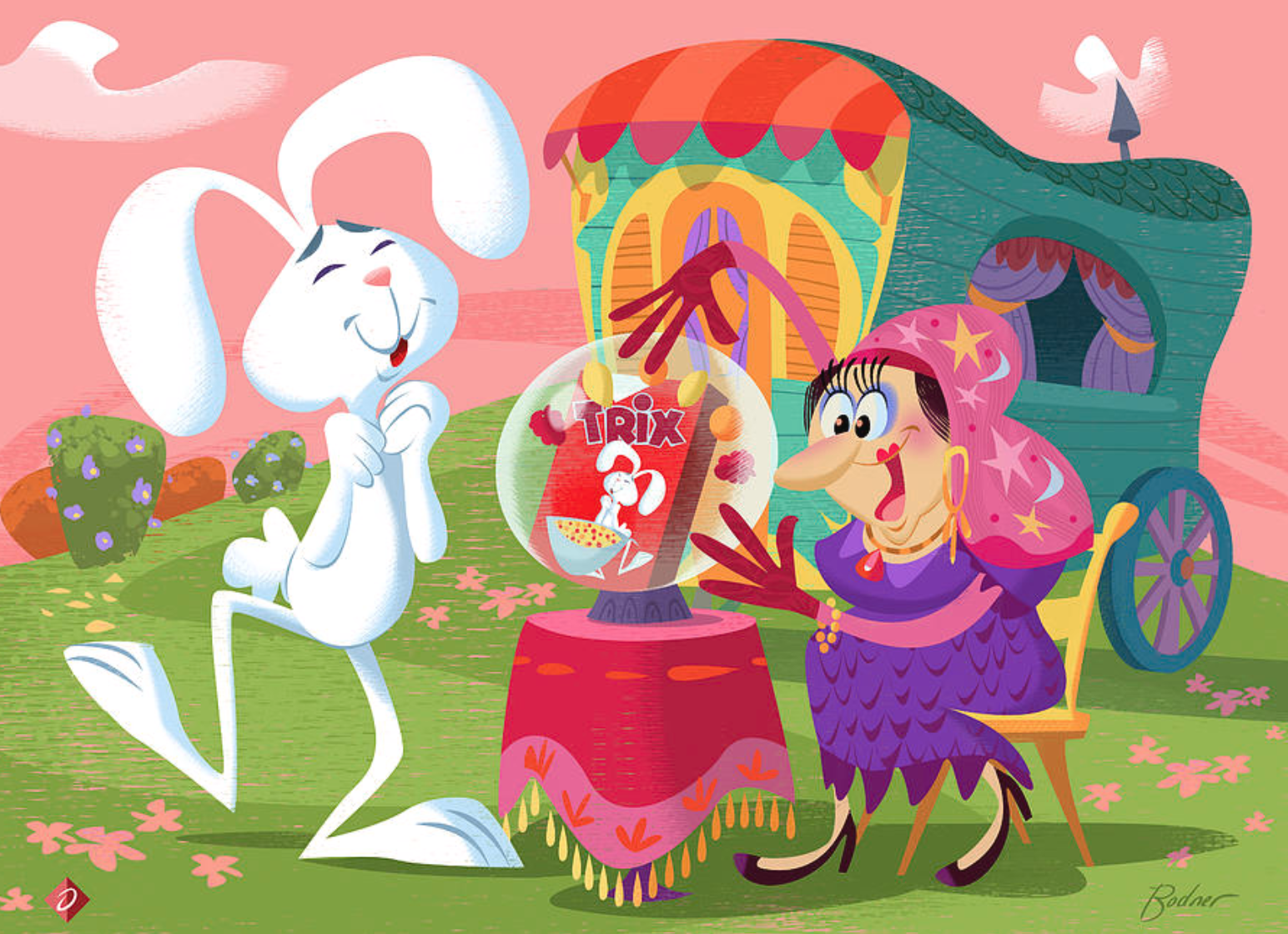
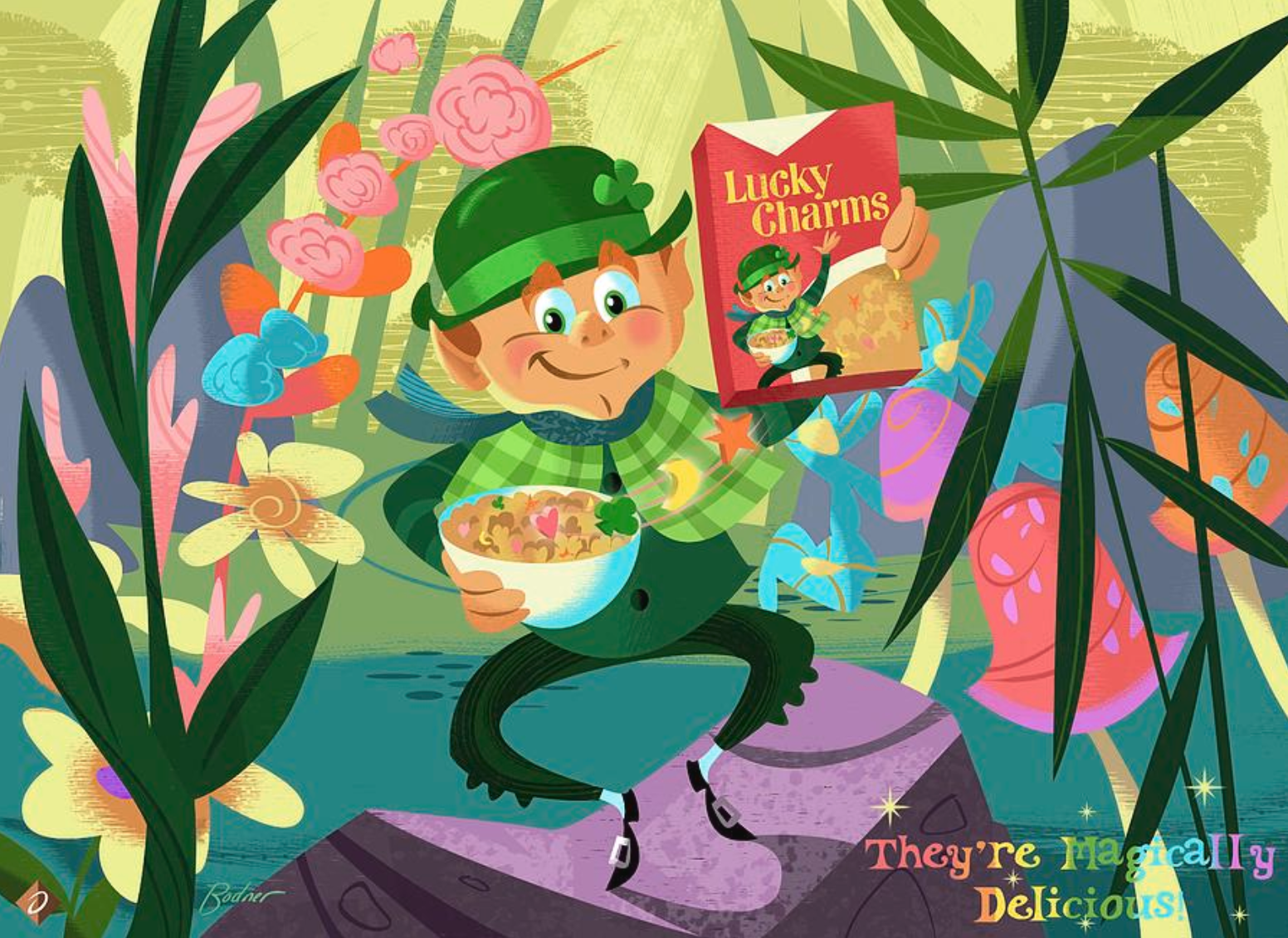
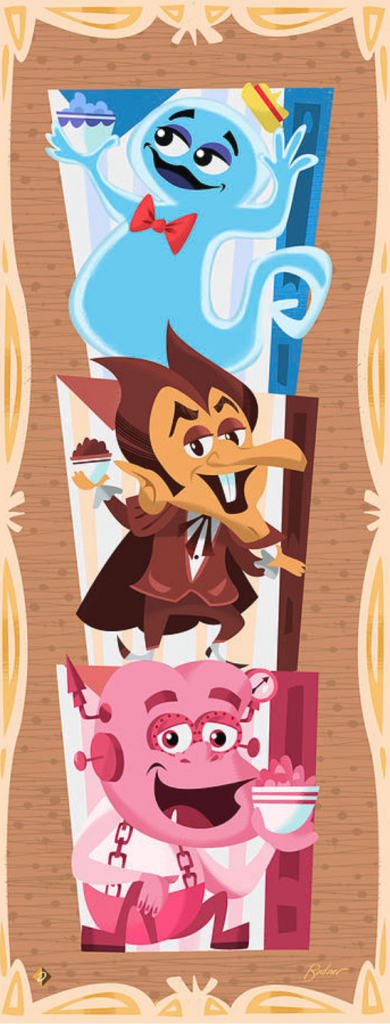
I love those things. They’re really great designs. I want to do my homage to that stuff. I love my version of fan boy stuff. I’m not really a superhero kind of artist, but I thought maybe if I take the shows that I liked as a kid, I’ll find my voice in those things. Some of them became like a comic book page. I thought it was kind of fun, because It’s not just one piece, but it’s like I’m telling a little story. I love doing these things. I also love doing these dimensional pieces. They are just a joy to do.
I can tell you’re a fan of the Addams Family and the Wild Wild West and other shows that have this intense cult fandom. You get these little nuances in the art that show you loved to watch each episode. It’s clear you’re a fan.
All those shows are so incredible. I could watch them forever.
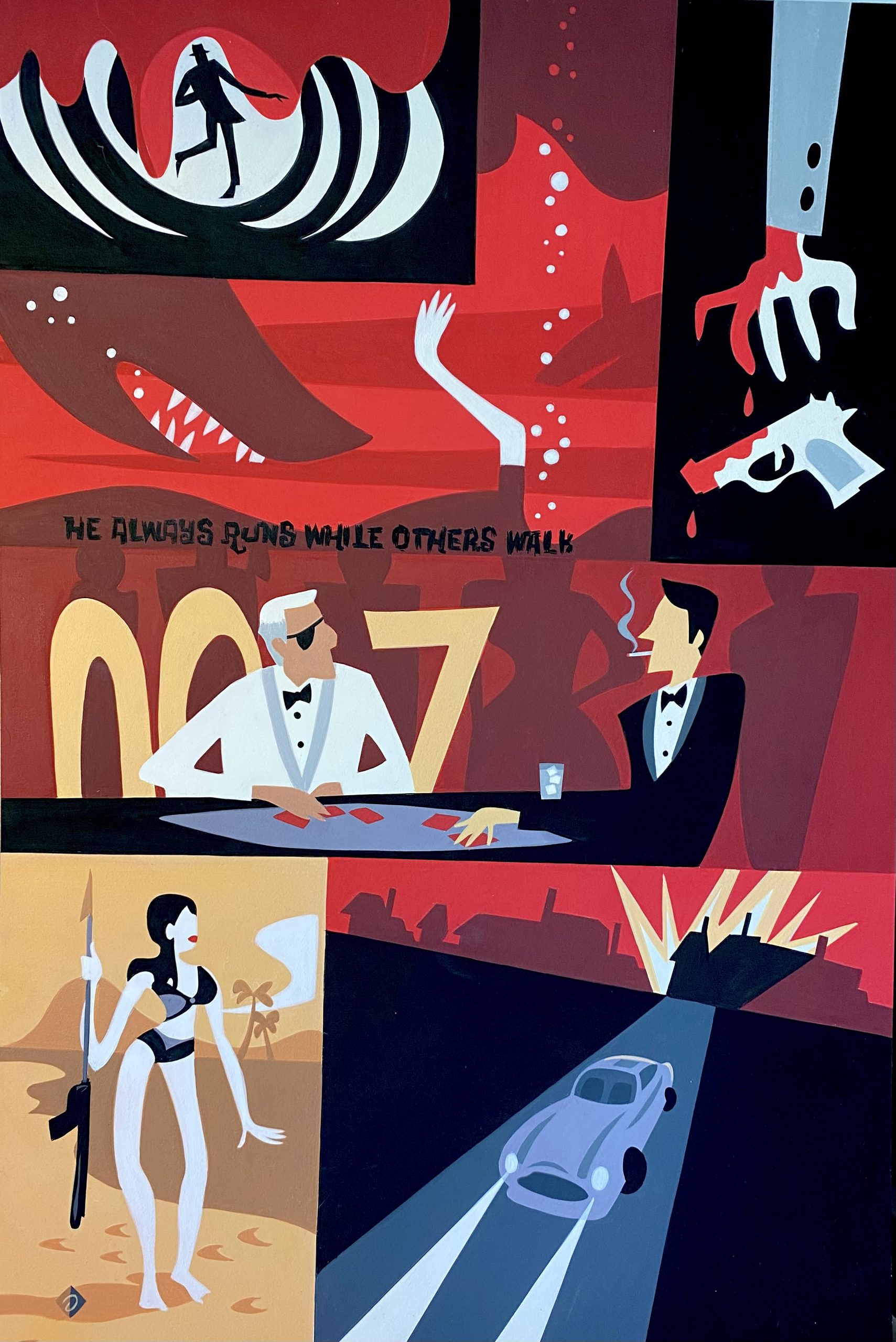
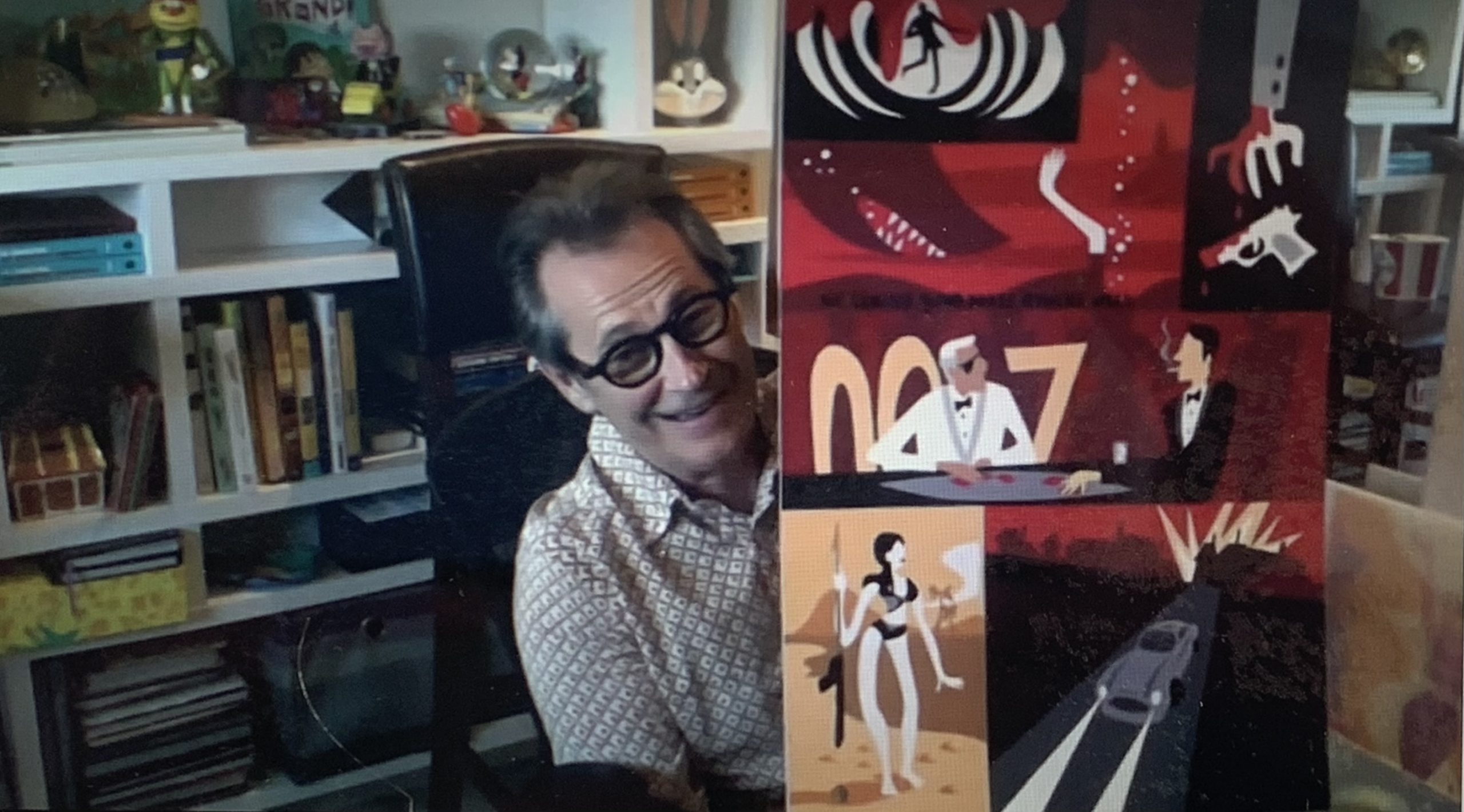
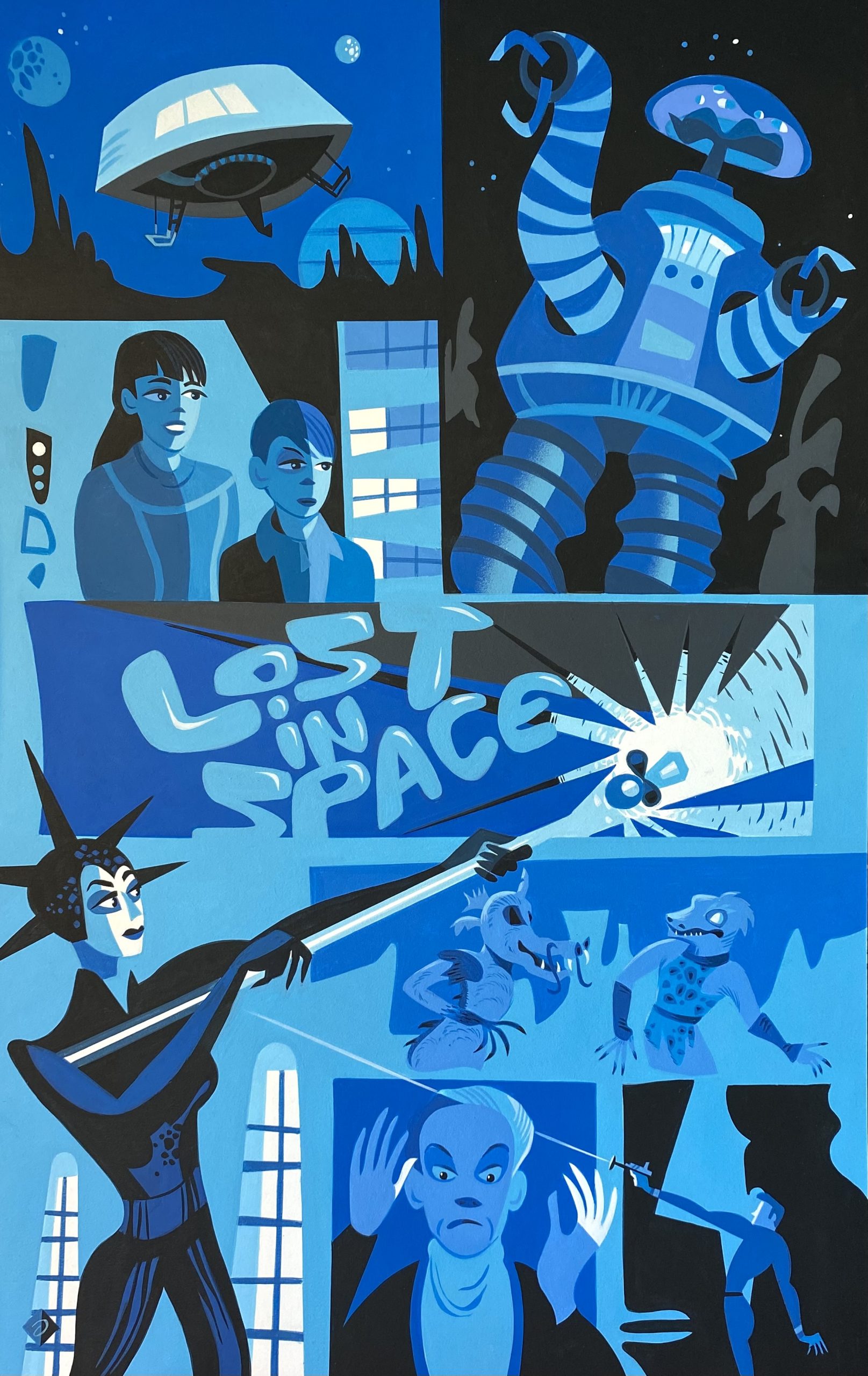
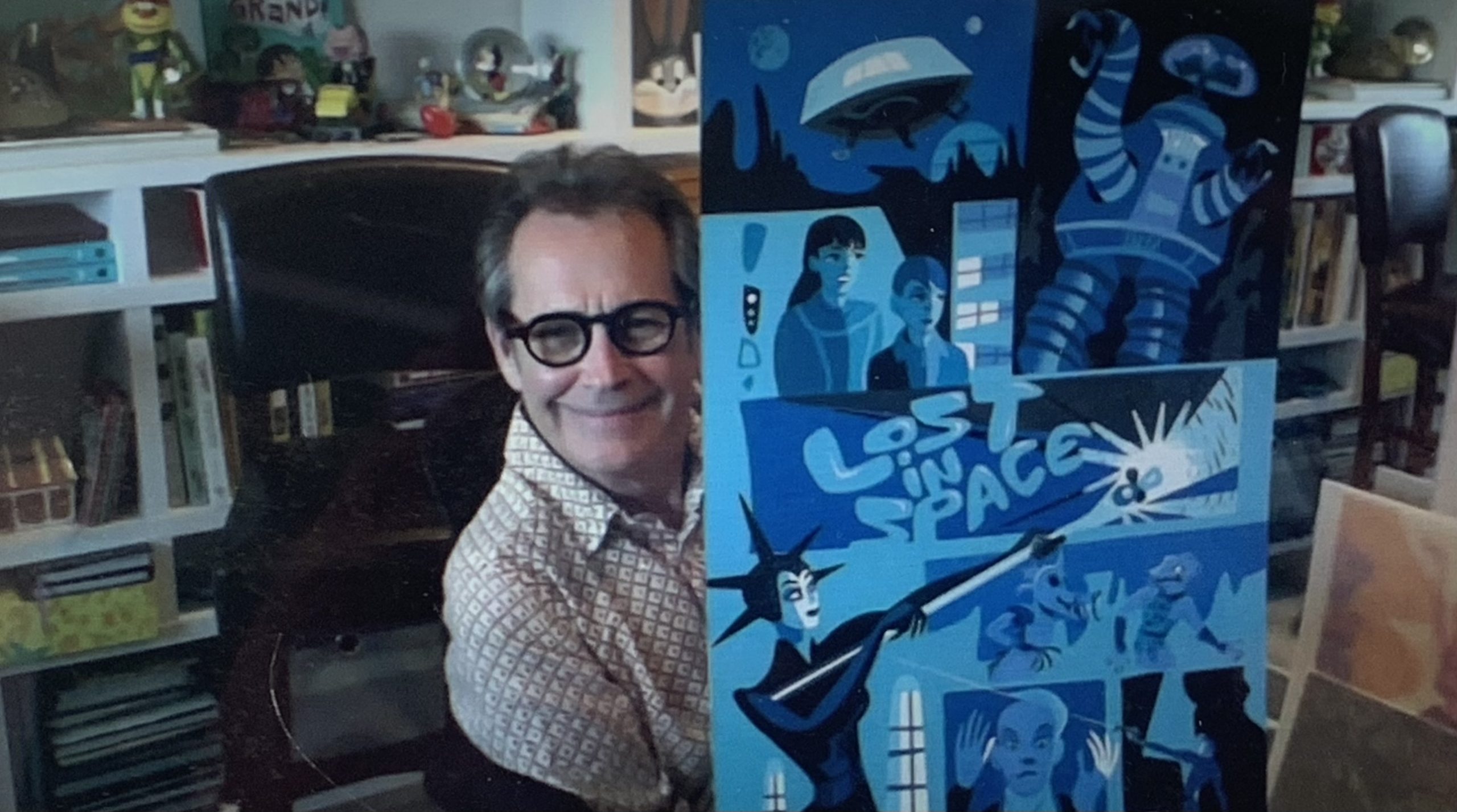
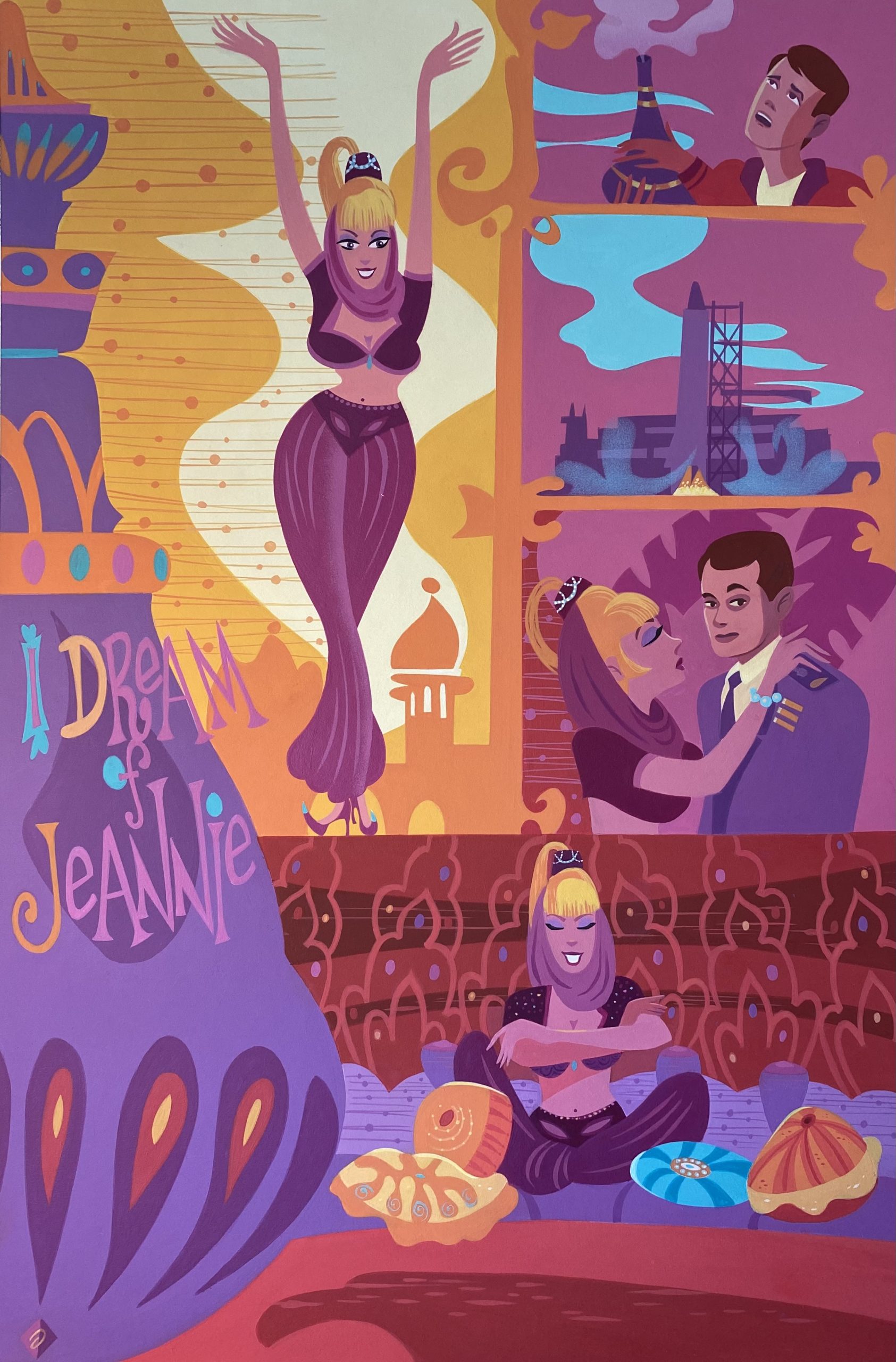
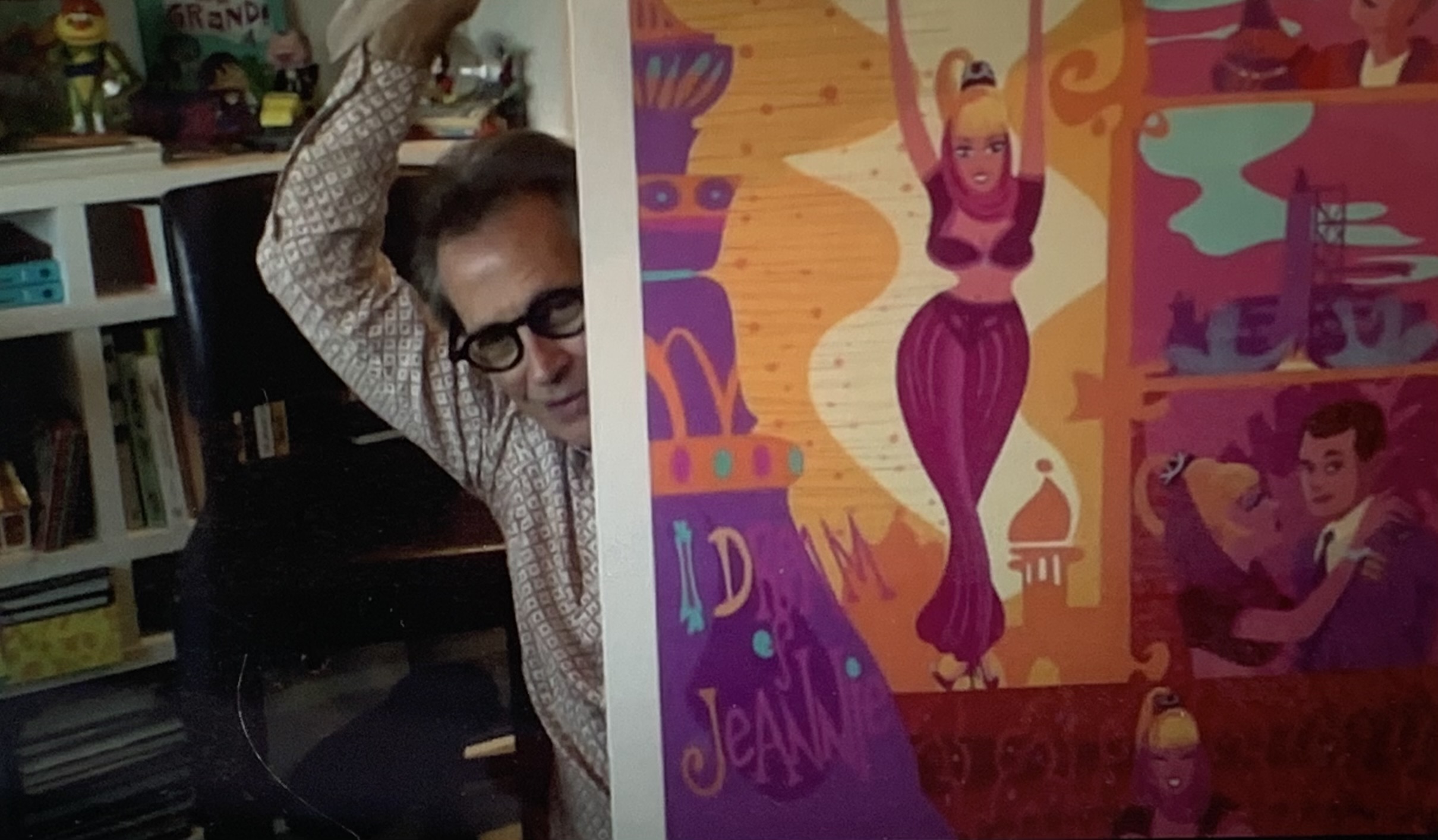
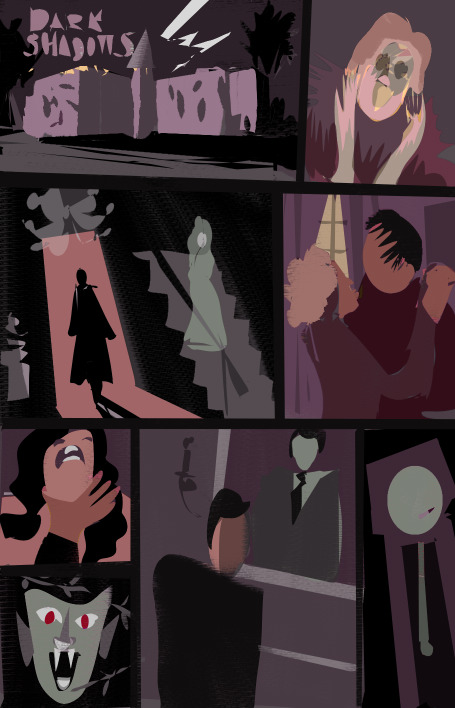
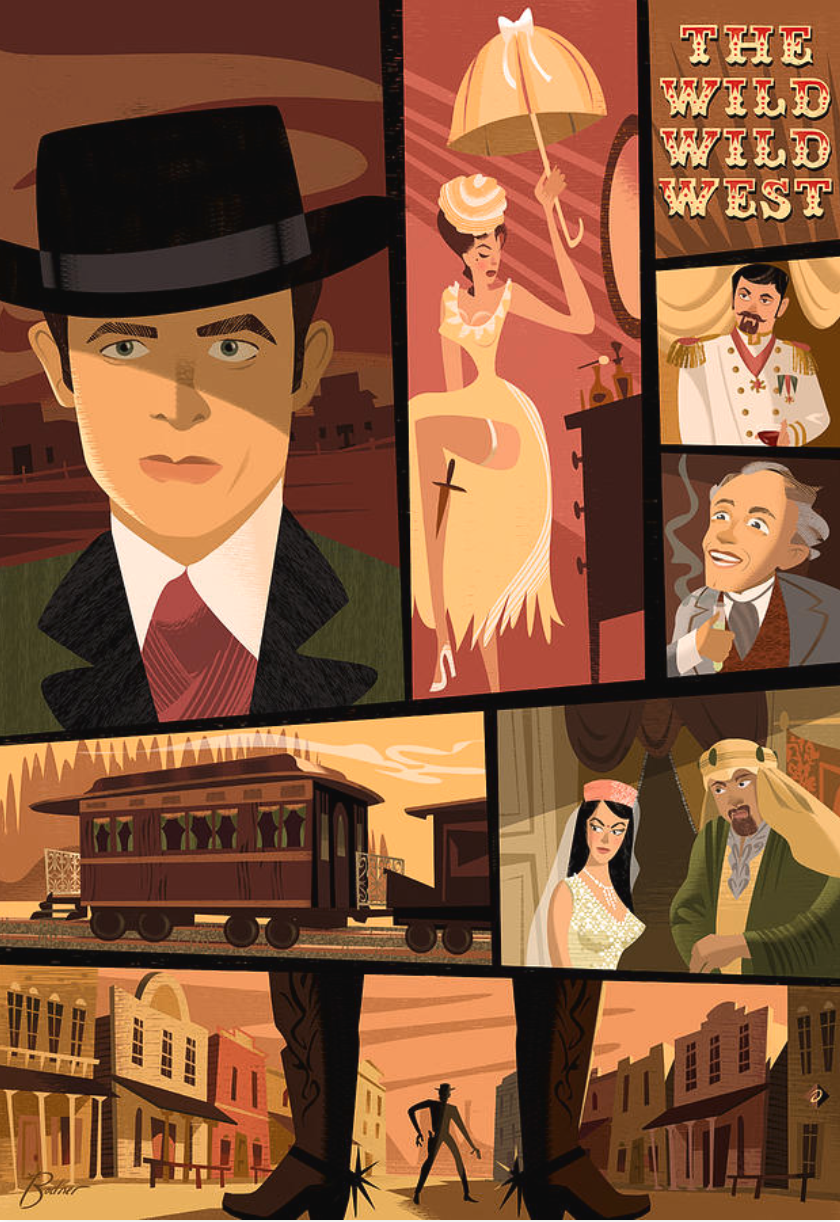
You have a list of shows you still want to do, right?
Oh yeah! Twilight Zone, Outer Limits, Star Trek, Man From Uncle, Bewitched, Gilligan’s Island, Brady Bunch, Pee Wee’s Playhouse and Charlie’s Angels. But there are so many great shows. I love so many and I remember them from my childhood and from reruns and they are just so fantastic.
There are also musicians and musicals that have inspired you.
Oh yes. I love music from all eras. Sometimes I wonder how I have so many different kinds of music and styles existing in my head at once!
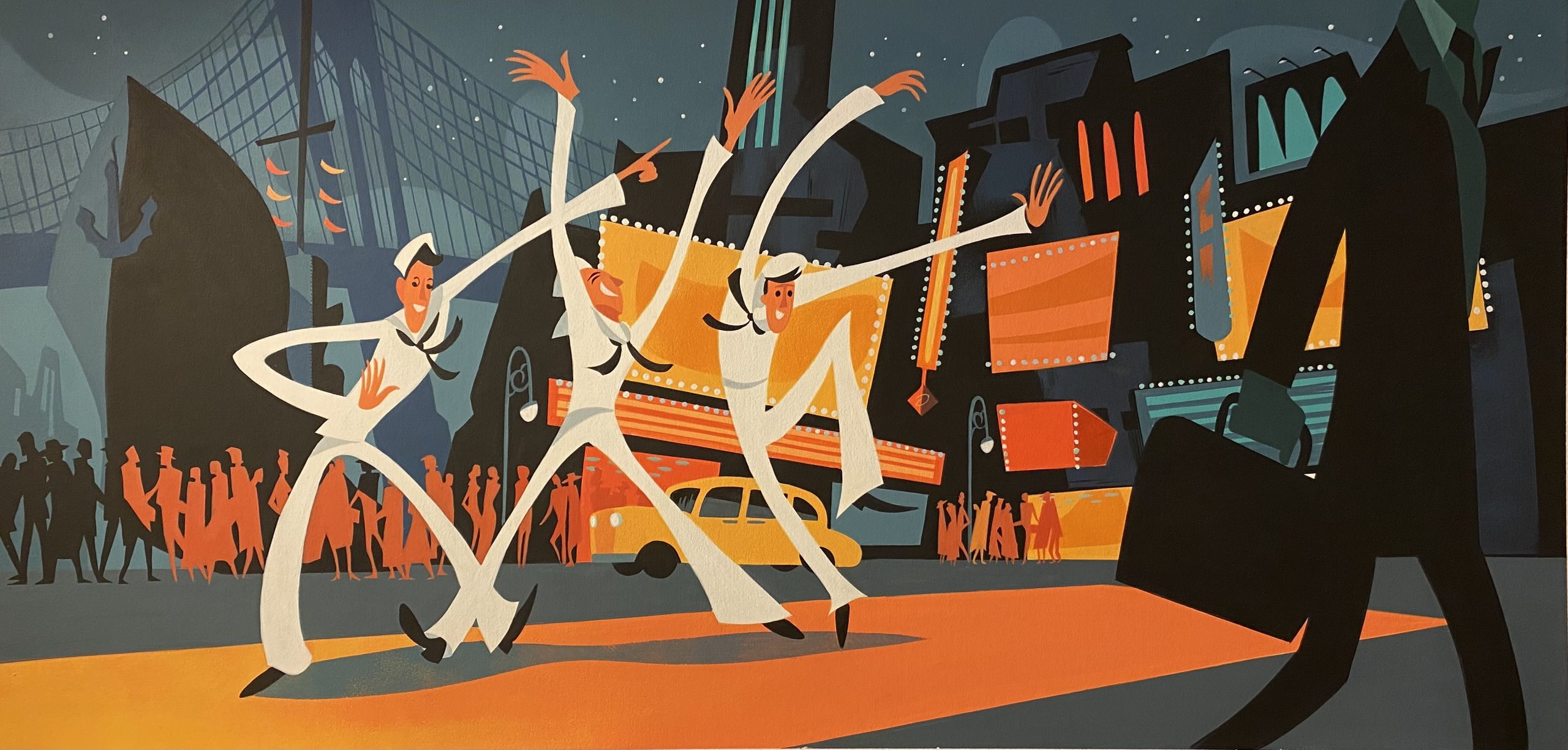
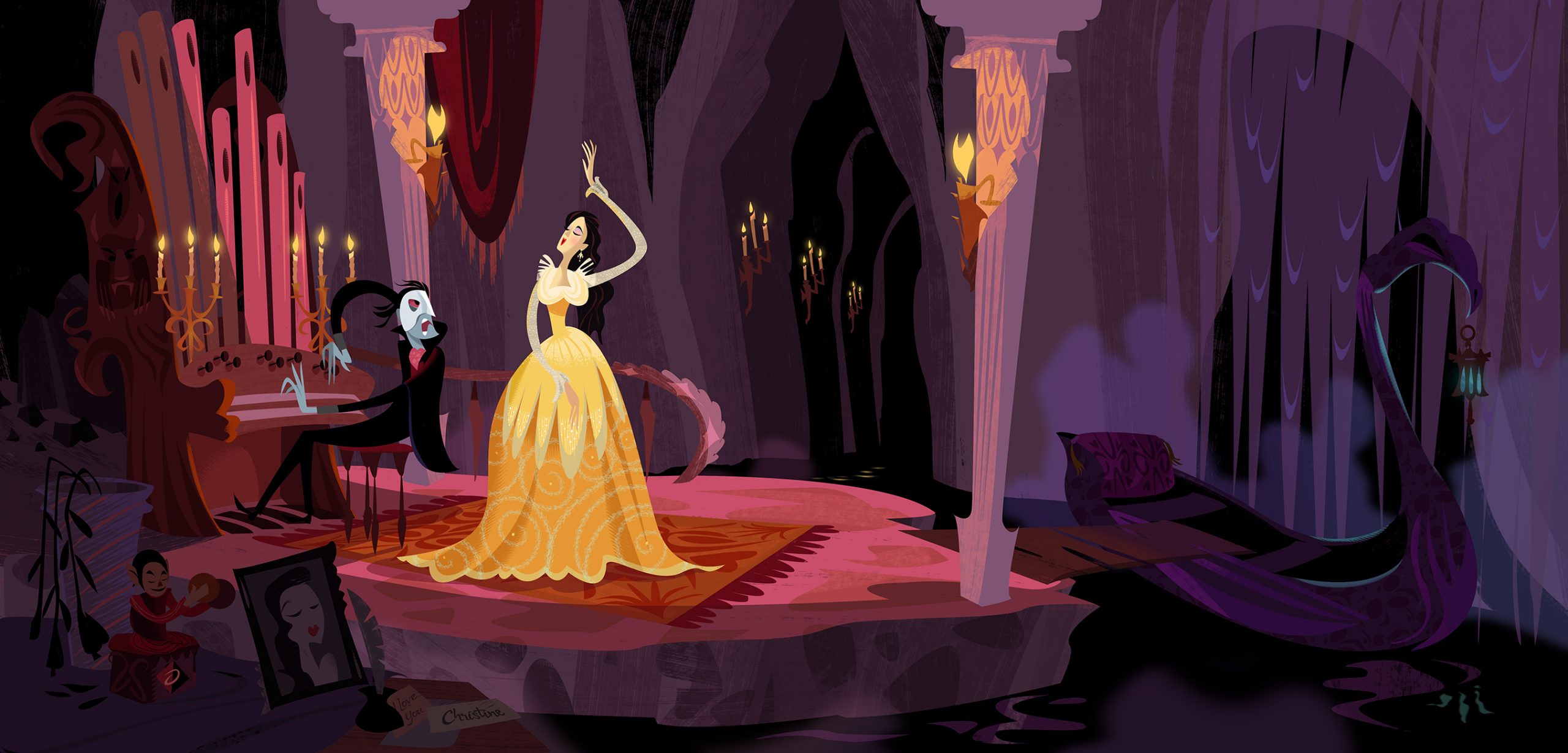
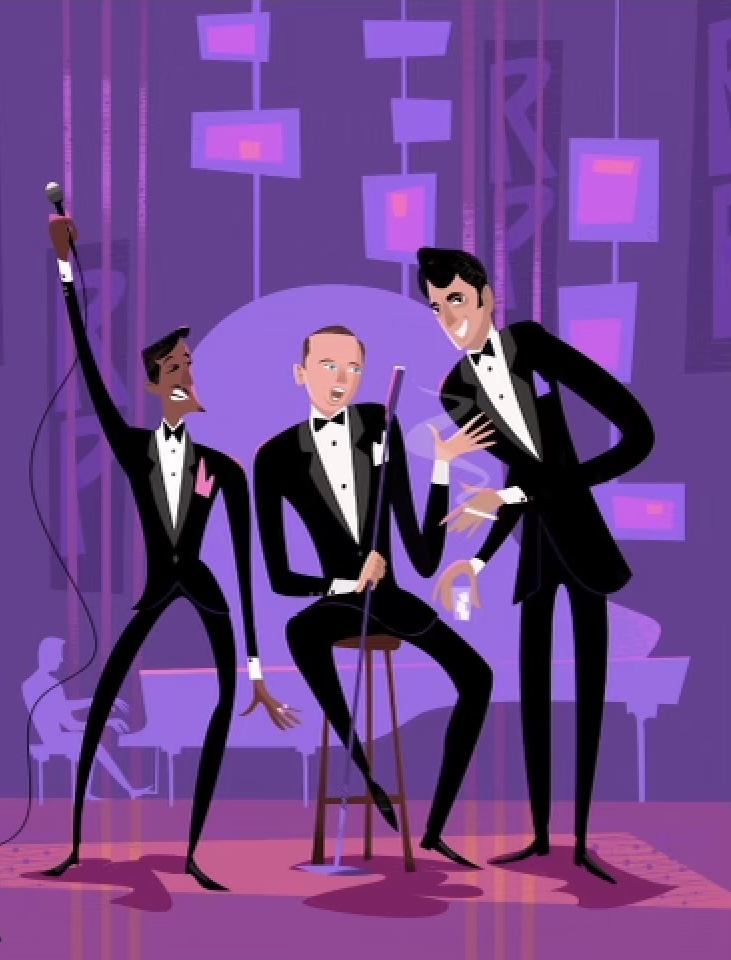
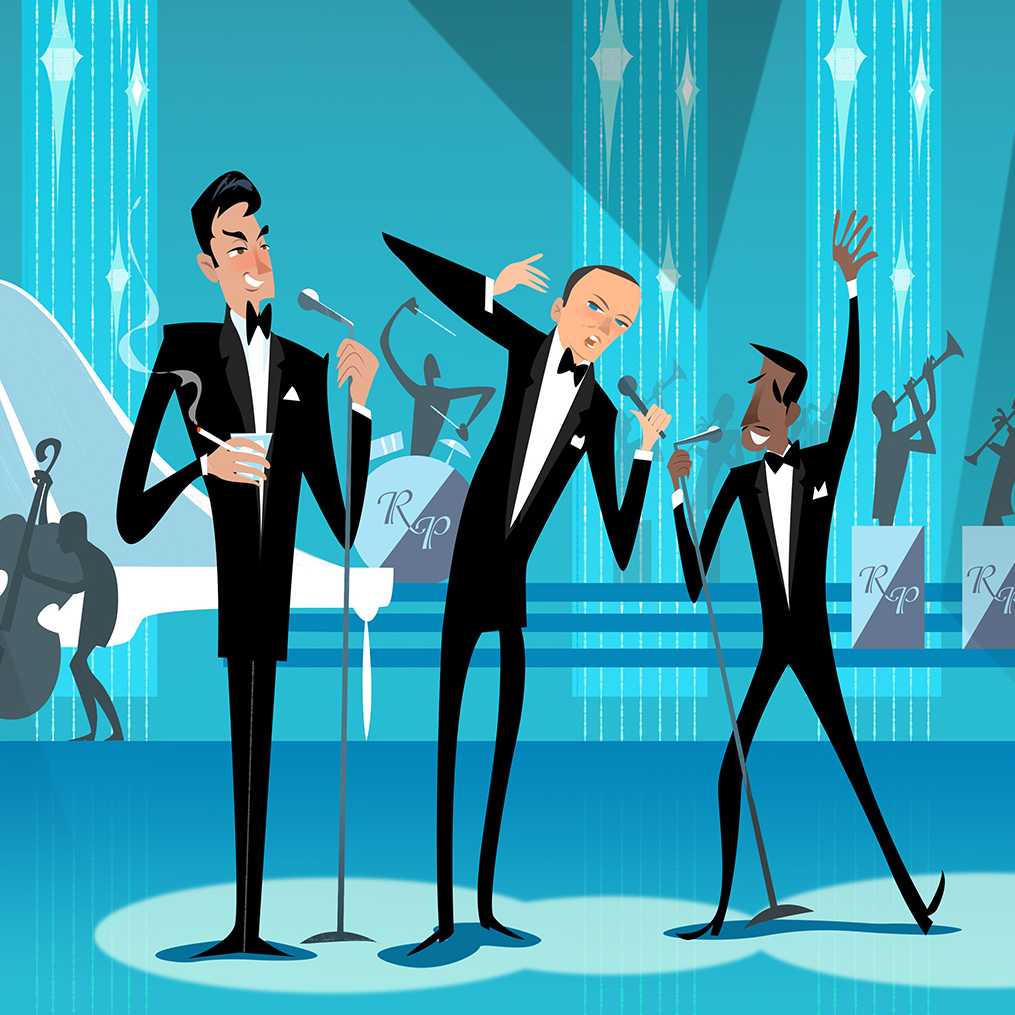
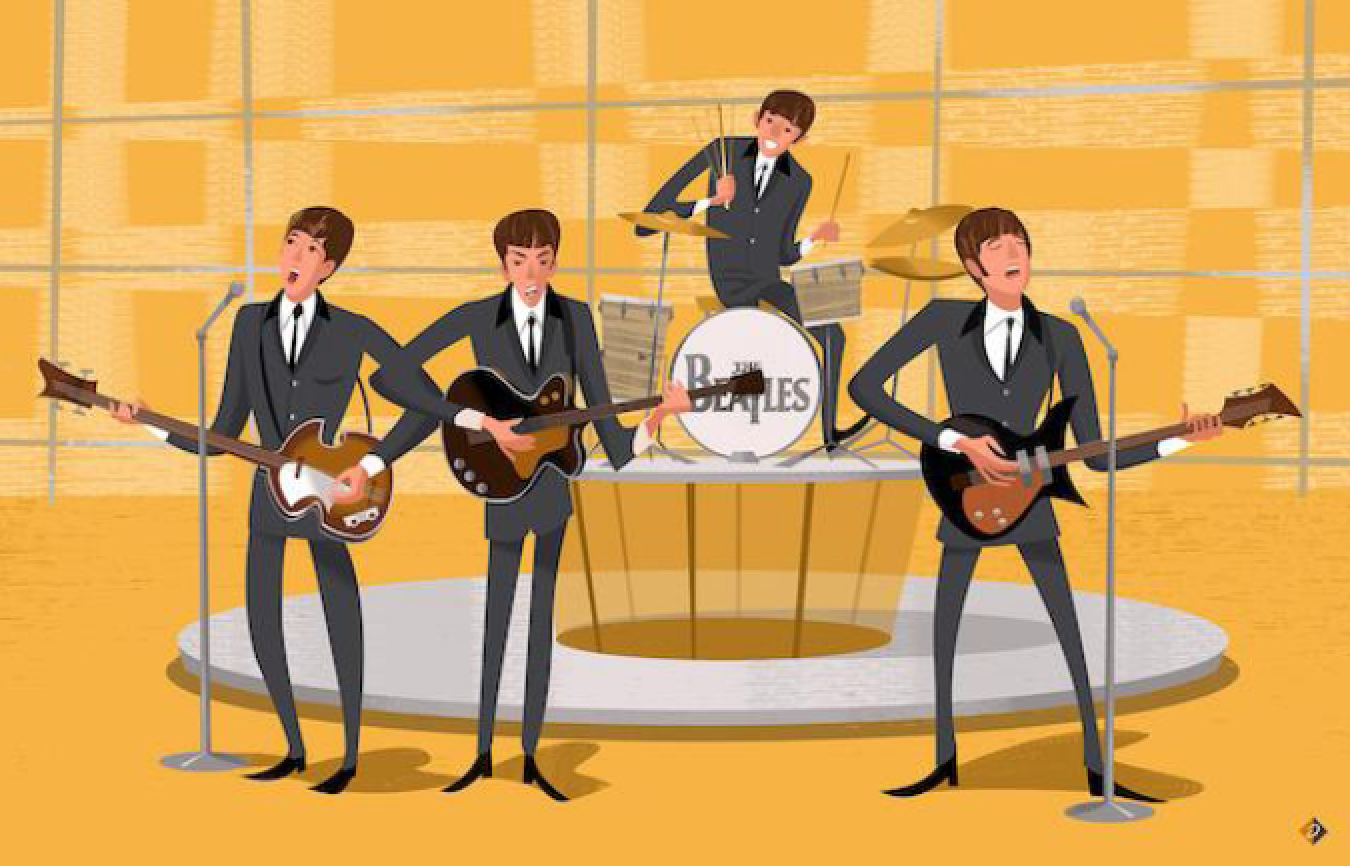
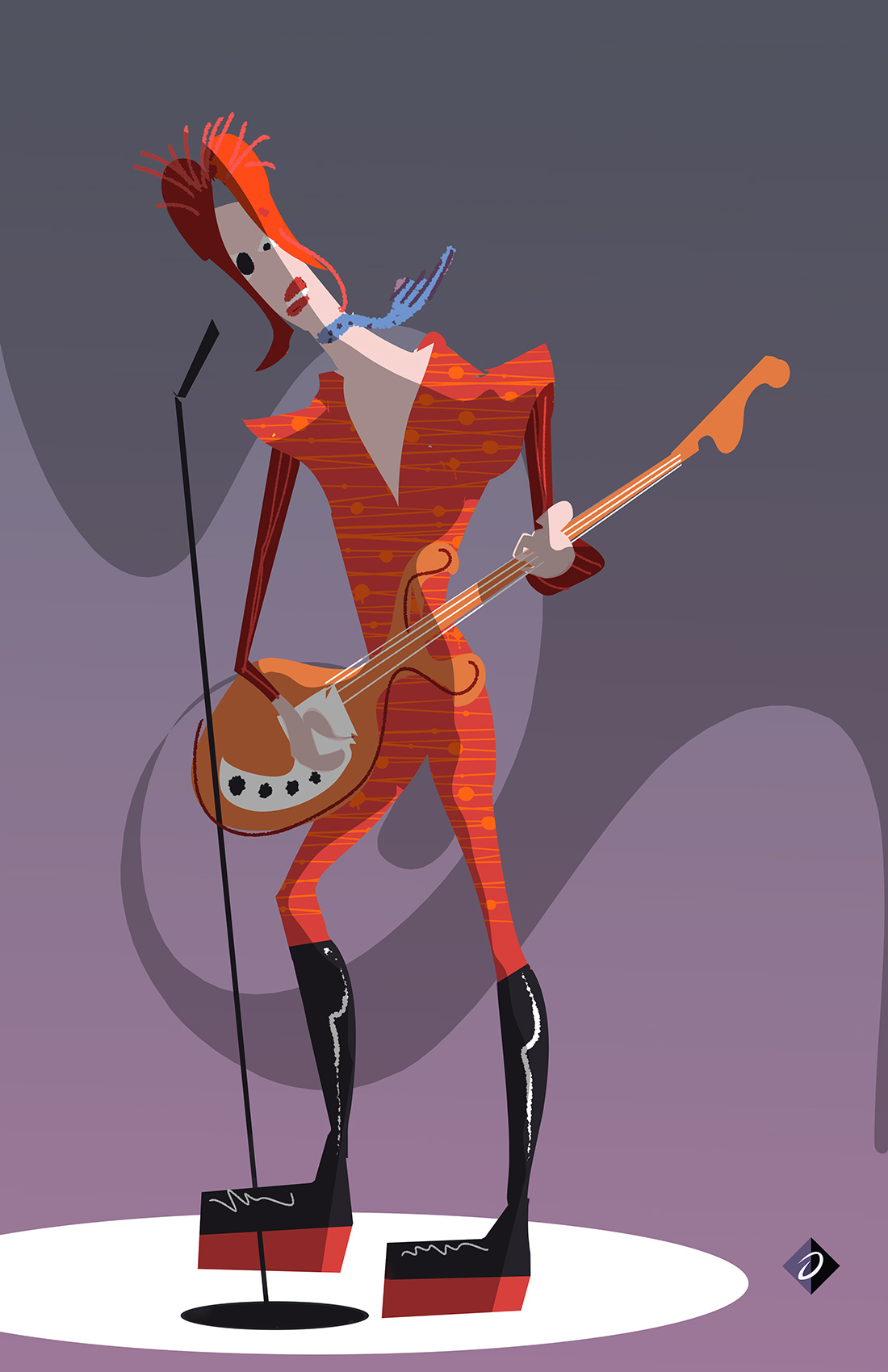
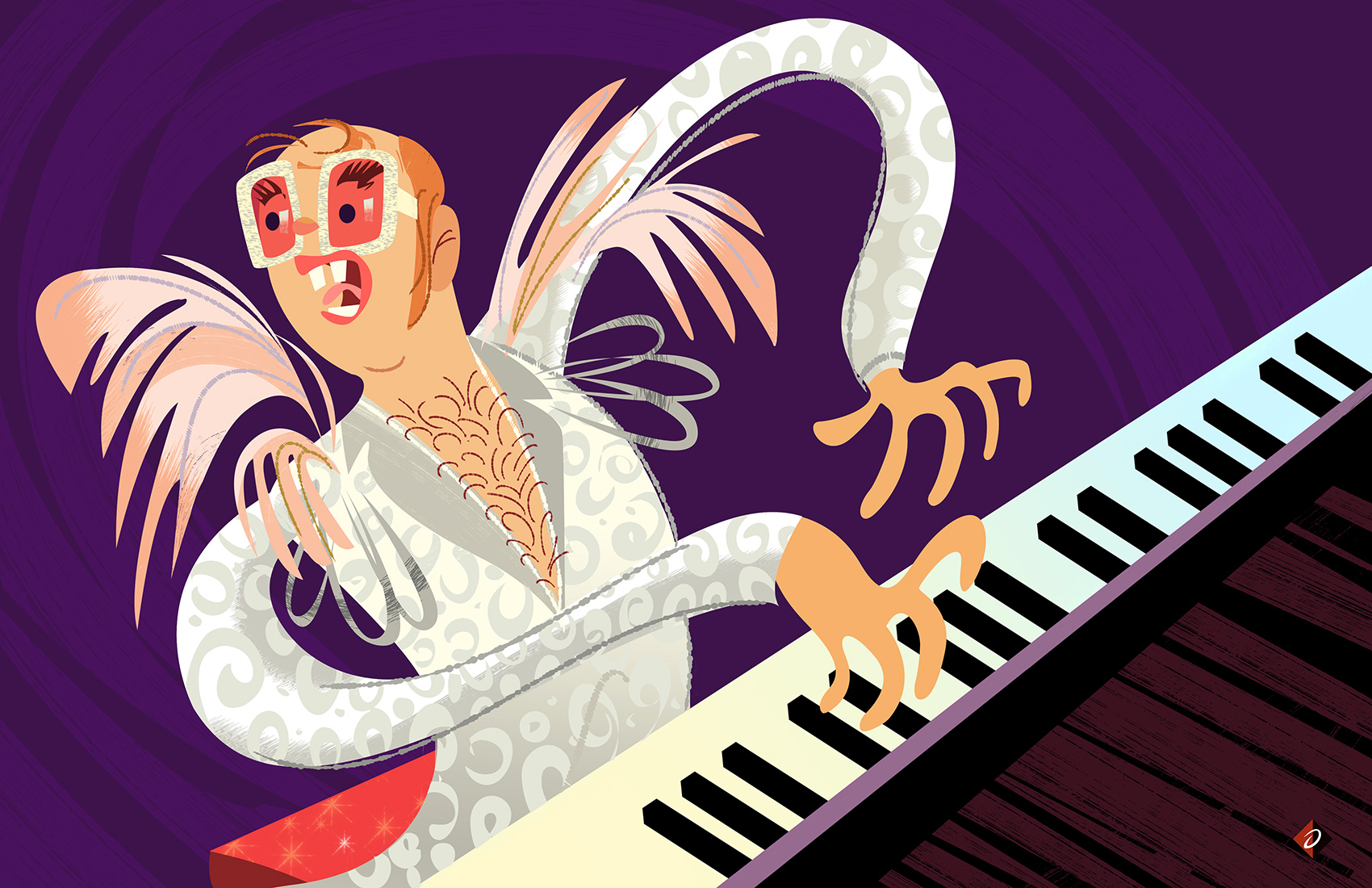
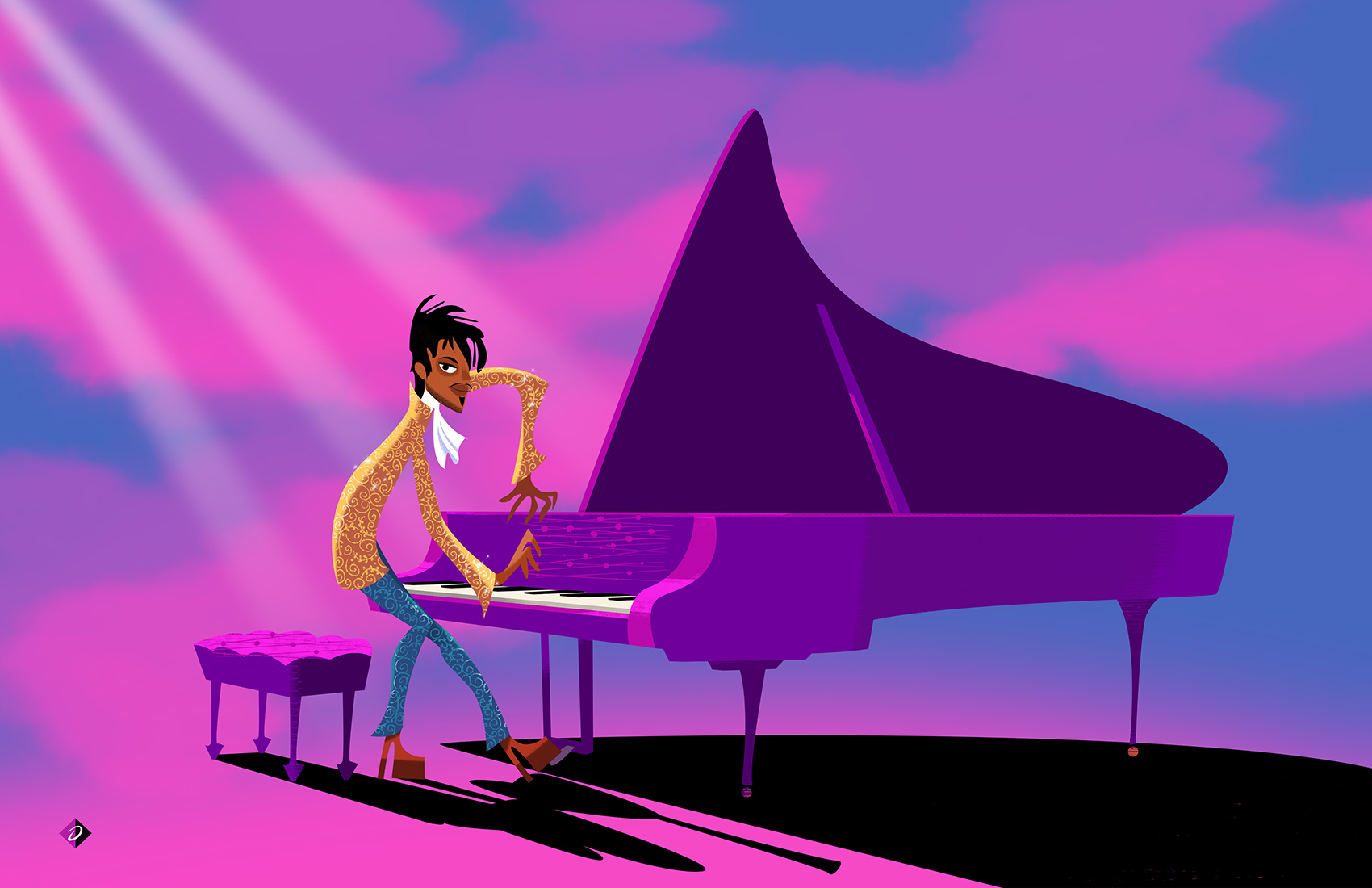
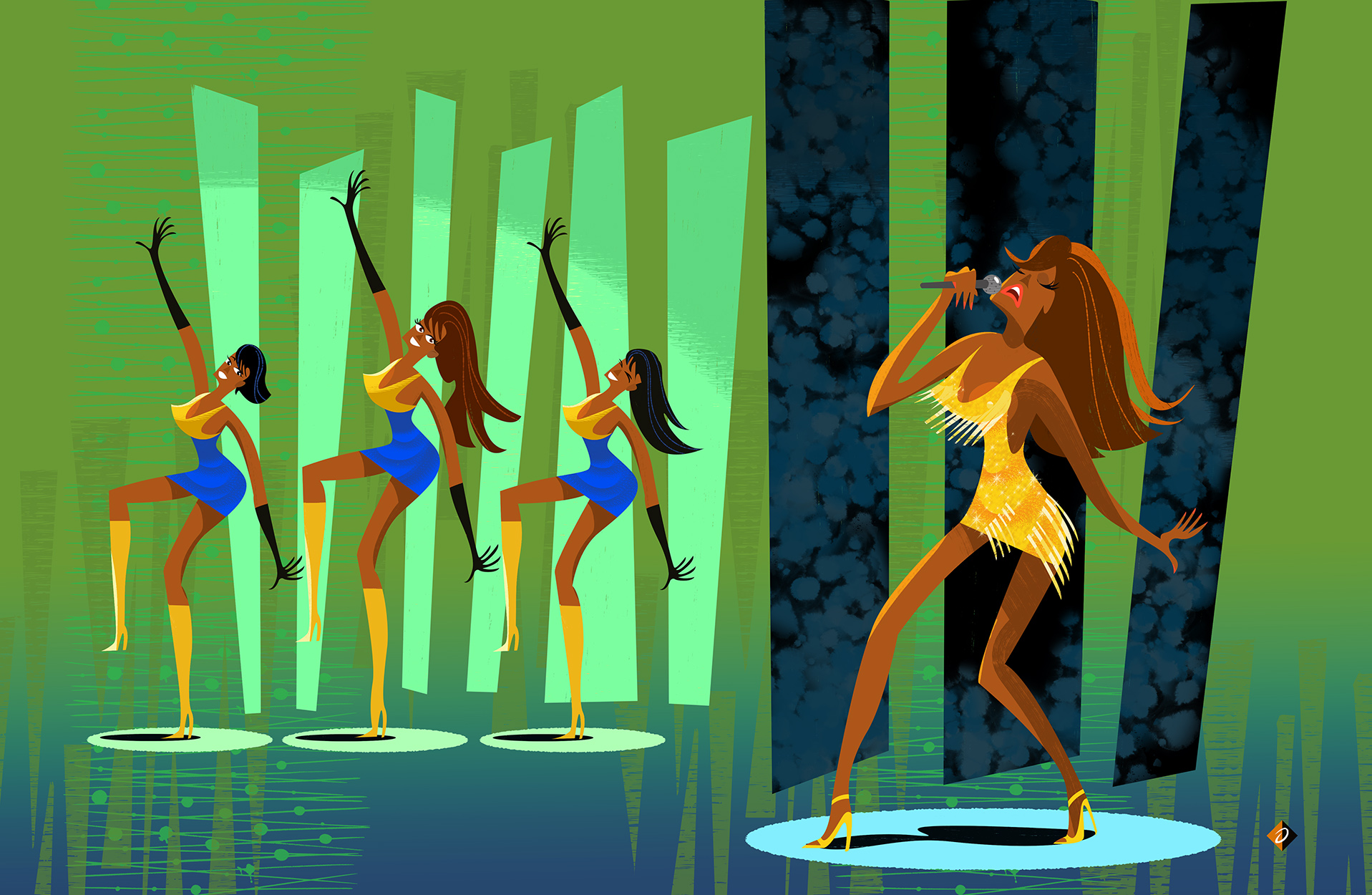
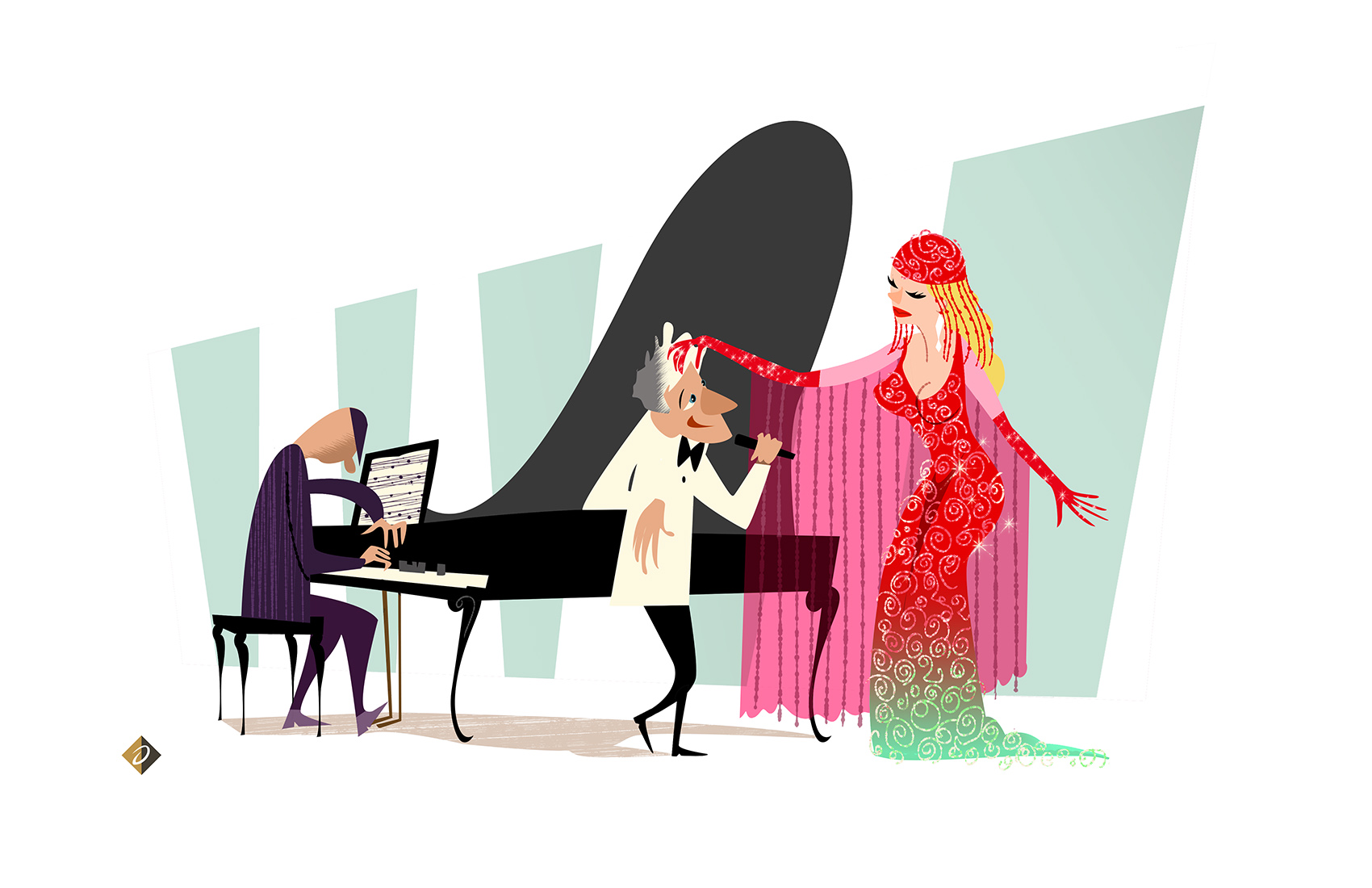
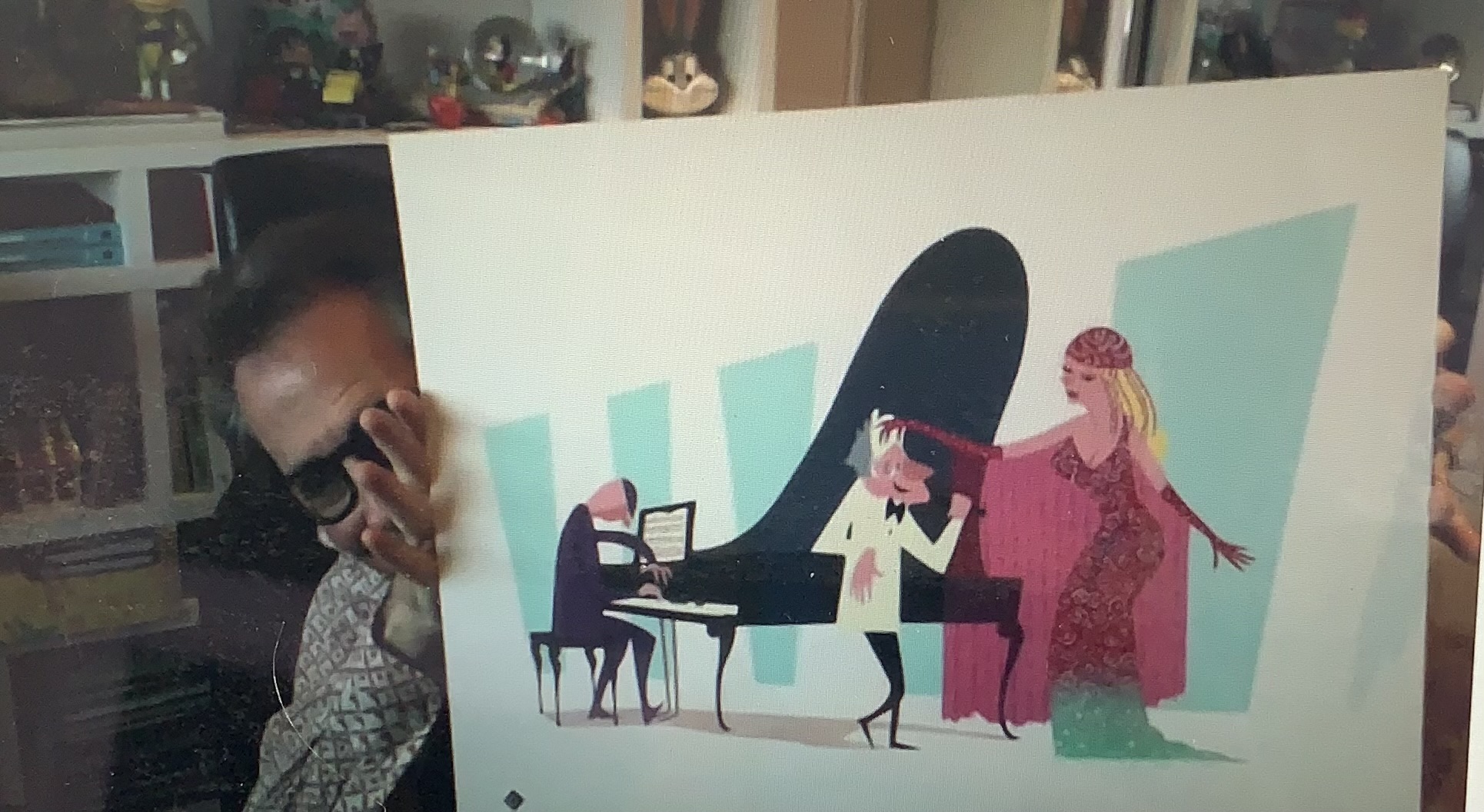
You said you wanted to mention one particular artist who was a great talent and a close friend.
Yes. Someone who was a great influence on me and is really one of those unsung heroes is Nyla Clayton. I met Nyla at Filmation. She was in the back of the studio airbrushing cels. And you’d never even know that this woman was Nyla of Beverly Hills in her day, which is an interior design house. She did these lavish, elaborate parties, and she was a larger-than-life figure, who was angry with life at the point when I met her, but we became friends. It turned out that she worked on Alice in Wonderland and the Enchanted Tiki Room, and snd she was in Imagineering at Disney for many years. She and Walt Disney kind of went head to head. She was a very strong person, and Walt didn’t like that, but she was very influential for quite some time. She was really good friends with Alice Davis. I inherited some things from Nyla, she gave to me. She was an assistant to Mary Blair for many years, and so I have a Mary Blair in my office here that was Nyla’s, and I have these little tiny totem poles that Nyla made that were the prototypes for the Enchanted Tiki Room. It’s hard to find pictures of her, but she was something else. When she came to Los Angeles, as a teenage girl, she went to live at this home that was like a hotel for aspiring actresses, and became really good friends with Katharine Hepburn and Joan Crawford. And I have a letter from Katharine Hepburn to Nyla. She was lifelong friends with these people. By the time I met her she was pretty embittered, but I was very, very happy to get to know her. I was in an art show at Filmation many years ago, and she came up and said she wanted to know who did that painting. It was a figure I did and some dance, and I was just starting to do these things. We became friends and I would you know visit her and talk to her. I know that she was a feiry fighter but she was very sweet to me. I always feel like there’s some thread of her work that comes out of in mine. She did these dimensional pieces that would have blown your mind, and now they don’t exist. Her family didn’t save this stuff. She had a lot to do with the Electric Light Parade in Disneyland. She was very influential. The only person who could really tell you in depth about her would be Alice Davis. It’s so sad that women like Nila from the history of Disney are unsung heroes.
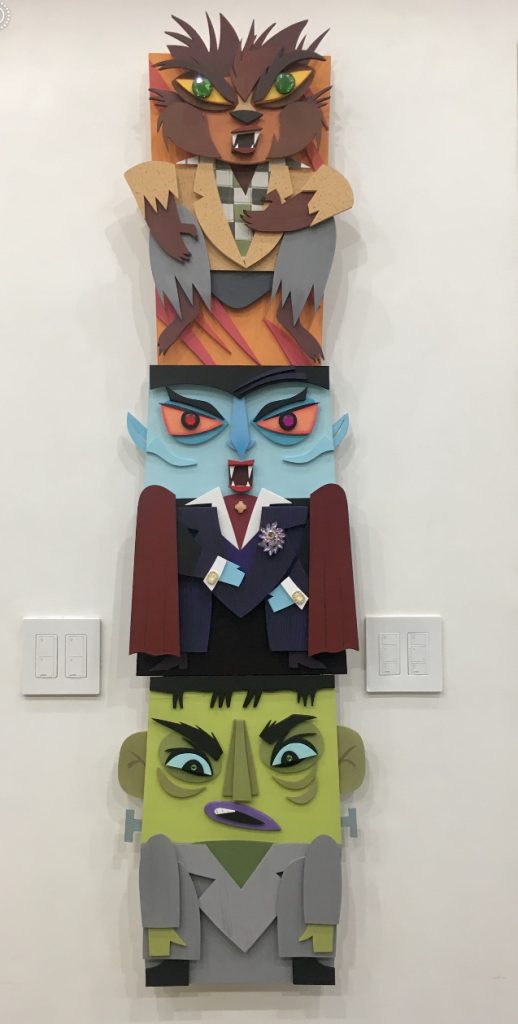
You have to fit creating your personal work in between working full time at Disney, right? You’re art director for Mickey Mouse Funhouse.
Yeah, I’m art directing that, and we’re in our second season. It’s been a joyous show. And I was so excited because some of the influences that I was really hoping that we could look at and get influenced by were from the Mouseketeers, and the Mickey Mouse Club, and I put a wall together of pictures from Mickey Mouse Club and the sets that Annette Funicello and the Mouseketeers danced in front of. They were fun and so cool looking and I thought this is kind of what the world has got to feel like a reflection of for Mickey Mouse. This is his world. Let’s bring him back with his roots here. Of course his roots are also my childhood. We did that, and we looked at that and went to Disneyland and looked at buildings in Toon Town and the Alice in Wonderland ride, and said, “We’ve got to get influenced by this stuff again, and not try to make this show look like every CG show that’s on, so it really is kind of nice that the studio got behind that, and liked the fact that it was an homage to the history of Disney.
We are thrilled to be able to offer the art of Alan Bodner, and premiere his original art inspired by the nostalgia of his youth, and you can see them all HERE!

